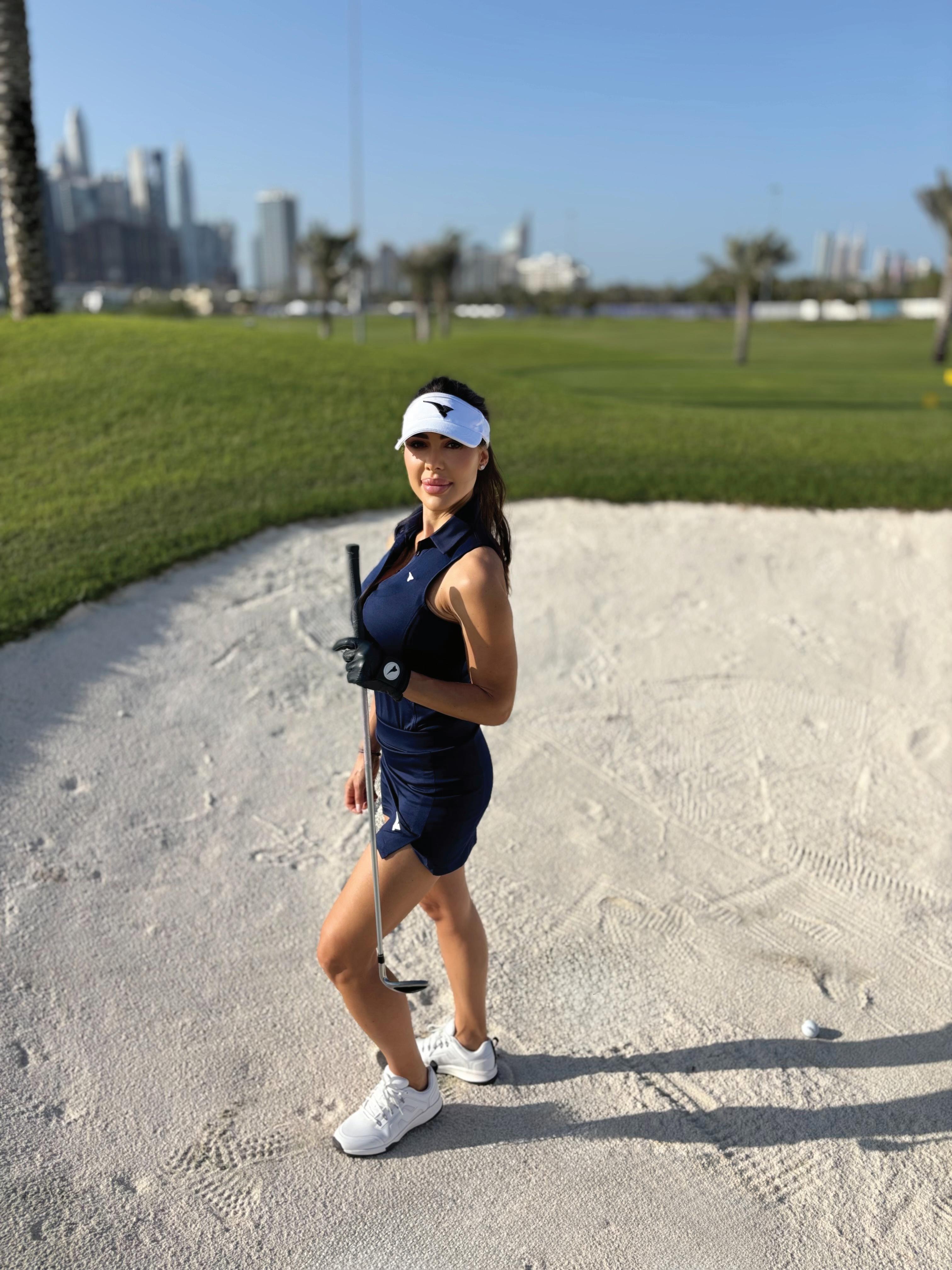THE MASTERS ISSUE

LEAN BACK & ENJOY
ARAB GOLF SERIES - A NEW ERA EMIRATES PGA & THE DUBAI GOLF TROPHY HOT LIST PART 3: WOODS & HYBRIDS WHERE TO PLAY: ROYAL GREENS GOLF & CC

DEFENDING CHAMPION SCOTTIE SCHEFFLER



















ARAB GOLF SERIES - A NEW ERA EMIRATES PGA & THE DUBAI GOLF TROPHY HOT LIST PART 3: WOODS & HYBRIDS WHERE TO PLAY: ROYAL GREENS GOLF & CC


















With a field size typically around 90 players, the Masters is the smallest of the four men’s major championships, yet few tournaments promote an international field as thoroughly as the Masters, which awards exemptions to the winners of the Asia-Pacific Amateur and the Latin America Amateur. On the grounds at Augusta National, flags representing each player’s nationality fly above the scoreboard near the main entrance.





5 Rory’s Moment Augusta’s spotlight shines, but global golf is shifting fast, especially here.
BY HARRY GRIMSHAW
6 Jebel Sifah Play golf surrounded by the Al Hajar Mountains and the Gulf of Oman.
42 Wadi Safar Golf Saudi and the Diriyah Company partner up.
44 Arab Golf Series
The initiative is set to transform golf in the Arab world.
46 Gaining Global Recognition
UAE golfers are making heads turn at the top level tournaments.
8 The Fringe Tom Holland BY ALEX MYERS
10 The Shots You Need To Win The Masters
Players need to miss it in the right spot. BY
EDOARDO MOLINARI
BY HARRY GRIMSHAW
48 Clash Of The UAE’s Best
In the 26th edition of the Dubai Golf Trophy, can the Professionals stop the Amateurs dominance?
BY HARRY GRIMSHAW
50 The Race To Number One
The Emirates PGA is hotting up in the UAE.
BY HARRY GRIMSHAW
56 Sundays With Butch Six unforgettable Masters.
BY BUTCH HARMON
12 Augusta National Sometimes, you just have to take the conservative route.
BY RORY MCILROY
14 Use Ludvig Åberg’s Indoor Drill to Slot Your Swing
The uber-talented Swede has a great way to practice your swing at home.
BY DREW POWELL
16 Bend And Rip Joaquin Niemann’s unicorn swing makes him an elite ball-striker.
BY LUKE KERR-DINEEN
19 Zero Torque L.A.B. Golf BY PETER MORRICE
21 HOT LIST PART 3
• Fairway Woods
• Hybrids
BY MIKE STACHURA
36 Royal Greens Blending luxury with championship golf.
BY HARRY GRIMSHAW
38 Stunning Saudi Attracting an exclusive lifestyle experience.
40 Ask A Super Why can’t my course get fast greens like Augusta?
52 44 Masterpieces
The creation stories of Augusta National’s bunkers.
BY DEREK DUNCAN
64 Club News
All the recent news from within the Arab Golf Federation.
66 Club News
A gallery of just a handful of the local tournament winners in the amateur circuit within the region of the Middle East.
editor-in-chief Obaid Humaid Al Tayer
managing partner & group editor
Ian Fairservice
chief commercial officer
Anthony Milne
editor Harry Grimshaw
art director Clarkwin Cruz
editorial assistant Londresa Flores
publisher David Burke
general manager - production
S. Sunil Kumar
production manager Binu Purandaran
THE GOLF DIGEST PUBLICATIONS
editor-in-chief Jerry Tarde
senior director, business development & partnerships
Greg Chatzinoff
international editor Ju Kuang Tan
GOLF DIGEST USA
editor-in-chief Jerry Tarde
general manager Chris Reynolds
editorial director Max Adler
executive editor Peter Morrice
art director Bill Specht
managing editors Alan P. Pittman, Ryan Herrington
playing editors Collin Morikawa, Jordan Spieth, Bubba Watson
With majors, mergers, and MENA’s golf rising, 2025 is the sport’s biggest year yet.
BY HARRY GRIMSHAW
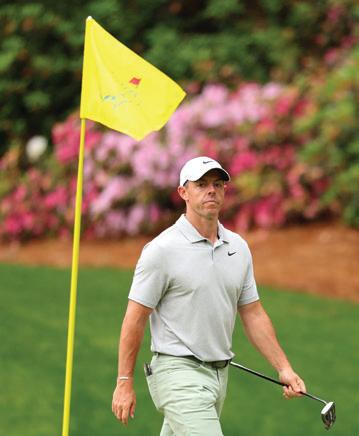
head office
Media One Tower, PO Box 2331, Dubai, UAE
Tel: +971 4 427 3000; Fax: +971 4 428 2266
dubai media city
SD 2-94, 2nd Floor, Building 2, Dubai, UAE
Tel: +971 4 390 3550; Fax +971 4 390 4845
Email: motivate@motivate.ae
abu dhabi
14th Floor, Office 1406, Makeen Tower, 9th Street, Al Zahiyah, PO Box 43072, Abu Dhabi, UAE
Tel: +971 2 677 2005; Fax: +971 2 657 3401
Email: motivate-adh@motivate.ae
saudi arabia
Regus Offices No. 455 - 456, 4th Floor, Hamad Tower, King Fahad Road, Al Olaya, Riyadh, KSA
Tel: +966 11 834 3595 / +966 11 834 3596
Email: motivate@motivate.ae
london
Motivate Publishing Ltd, Acre House, 11/15 William Road, London, NW1 3ER, UK
Email: motivateuk@motivate.ae
WITH THE FIRST Men’s major of the year finally here, all eyes are on Augusta National for the 2025 Masters.
The big question—can Scottie Scheffler defend his title, or will we see a resurgent Rory McIlroy finally complete his career Grand Slam?
nounced, details remain unclear, and tensions between golf’s global tours continue. Players and fans on both sides are eager for clarity, and with big names in the game voicing strong opinions, the future of professional golf remains uncertain. And that’s even with Donald Trump’s involvement in negotiations! Very much two steps forward, one step back at the moment.
Closer to home here in the Middle East, regional golf is thriving. The paid ranks on the HotelPlanner Tour and Clutch Pro Tour are welcomed to the Arab world for events in the United Arab Emirates, Oman and Morocco this month, where there will be plenty of strong competition, with rising local talents also using these circuits as a springboard to bigger things.
The Emirates PGA continues to be a proving ground for local pros, while the Arab Golf Federation has announced its new Arab Golf Series to showcase the region’s best players.
Golf in the Middle East is undoubtedly booming, and with world-class facilities across the UAE, Saudi Arabia, and beyond, it’s no surprise we’re seeing more international players training and competing here.
the U.S.A. Published by Warner Bros. Discovery. Principal office: Golf Digest, 230 Park Avenue South, New York, NY, 10003. Warner Bros/Discovery Luis Silberwasser, Chairman & CEO TNT Sports; Gunnar Wiedenfels, Chief Financial Officer. Periodicals postage paid at New York, N.Y., and at additional mailing offices.
Tiger Woods has confirmed that another setback has halted his return to competitive action, since the passing of his mother. The 15-time major champion has ruptured the Achilles tendon in his left leg. It was presumed that Tiger was doing everything he could to prepare for this years Masters, but typical recovery times for the surgery he’s undergone, make it very unlikely that he’ll be anywhere near ready to play the year’s first major. The last time Tiger played competitively, other than TGL of course, was at Royal Troon for last year’s Open Championship.
One thing’s for sure though, come April, Augusta’s azaleas won’t be the only thing in full bloom, as off the course, the ongoing negotiations between the PGA Tour and LIV Golf remain a major talking point. While the framework for a deal was an-
With so much happening on the global and regional golf scene, 2025 is very much shaping up to be an incredible year for the sport.
Whether you’re watching the Masters from your couch or teeing it up here in the desert, there’s never been a better time to be a golf fan.







harry.grimshaw@motivate.ae @harrygrimshaw / @golfdigestme

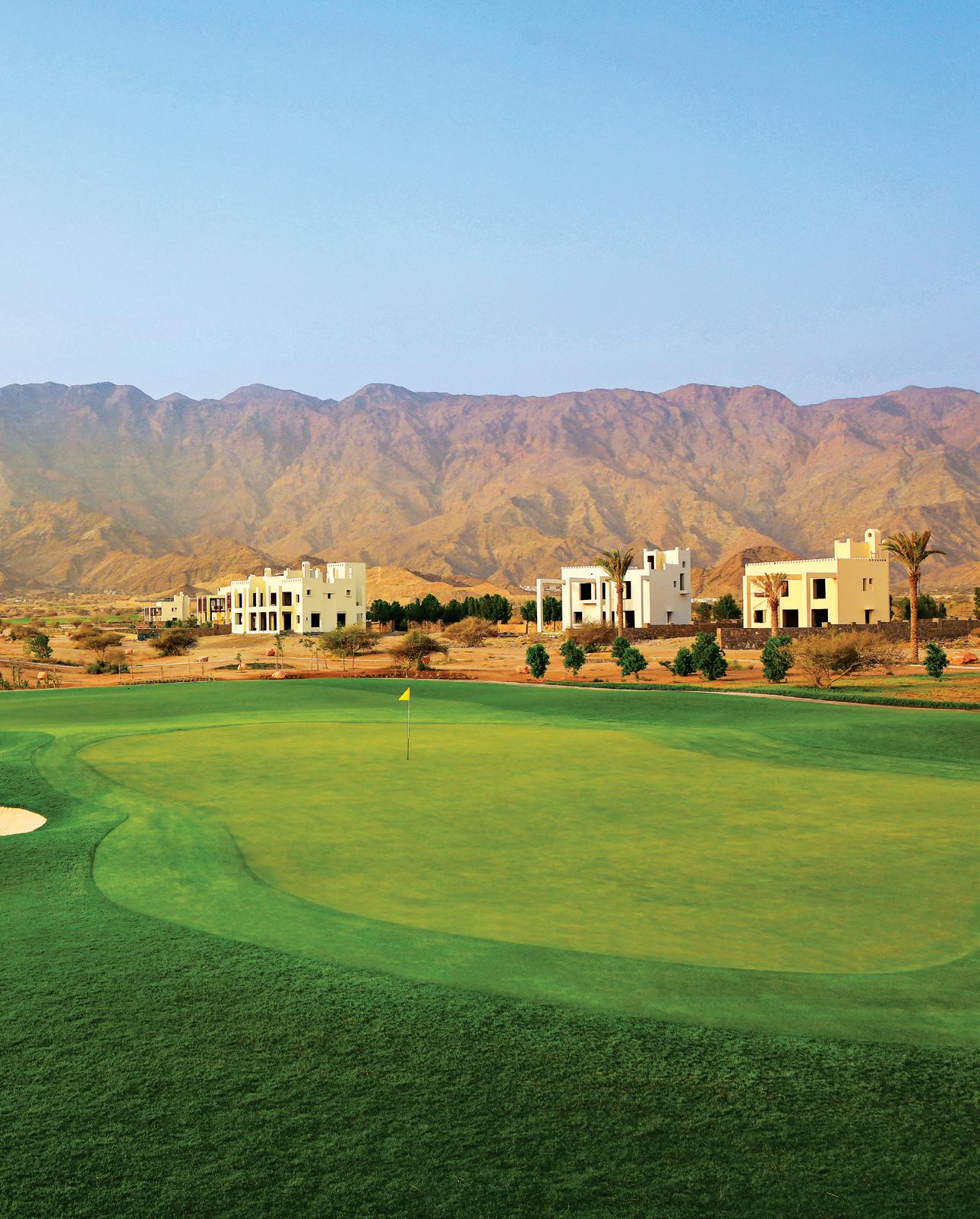
Play golf surrounded by the Al Hajar Mountains and the Gulf of Oman
Just 45 minutes from Muscat, Oman’s vibrant capital, Jebel Sifah effortlessly blends into the region’s spectacular landscapes. Its nine-hole, par-36 golf course is a true gem. Designed by renowned regional architect Peter Harradine, this was his first-ever seaside course, crafted to reflect the stunning natural surroundings of Jebel Sifah.
Featuring natural wadis and strategically placed greenside bunkers, the course offers a challenge for experienced golfers while remaining accessible and enjoyable for beginners. From the elevated tees, breathtaking views of the sea and mountains create an unforgettable golfing experience.
The course can be played as an 18-hole, par-72 layout, with five tee locations ranging from 5,686 to 7,268 yards.
But the greatest challenge might just be staying focused amid the stunning views!
Tom Holland’s odyssey from child dancer to one of Hollywood’s biggest stars (and best golfers)
BY ALEX MYERS
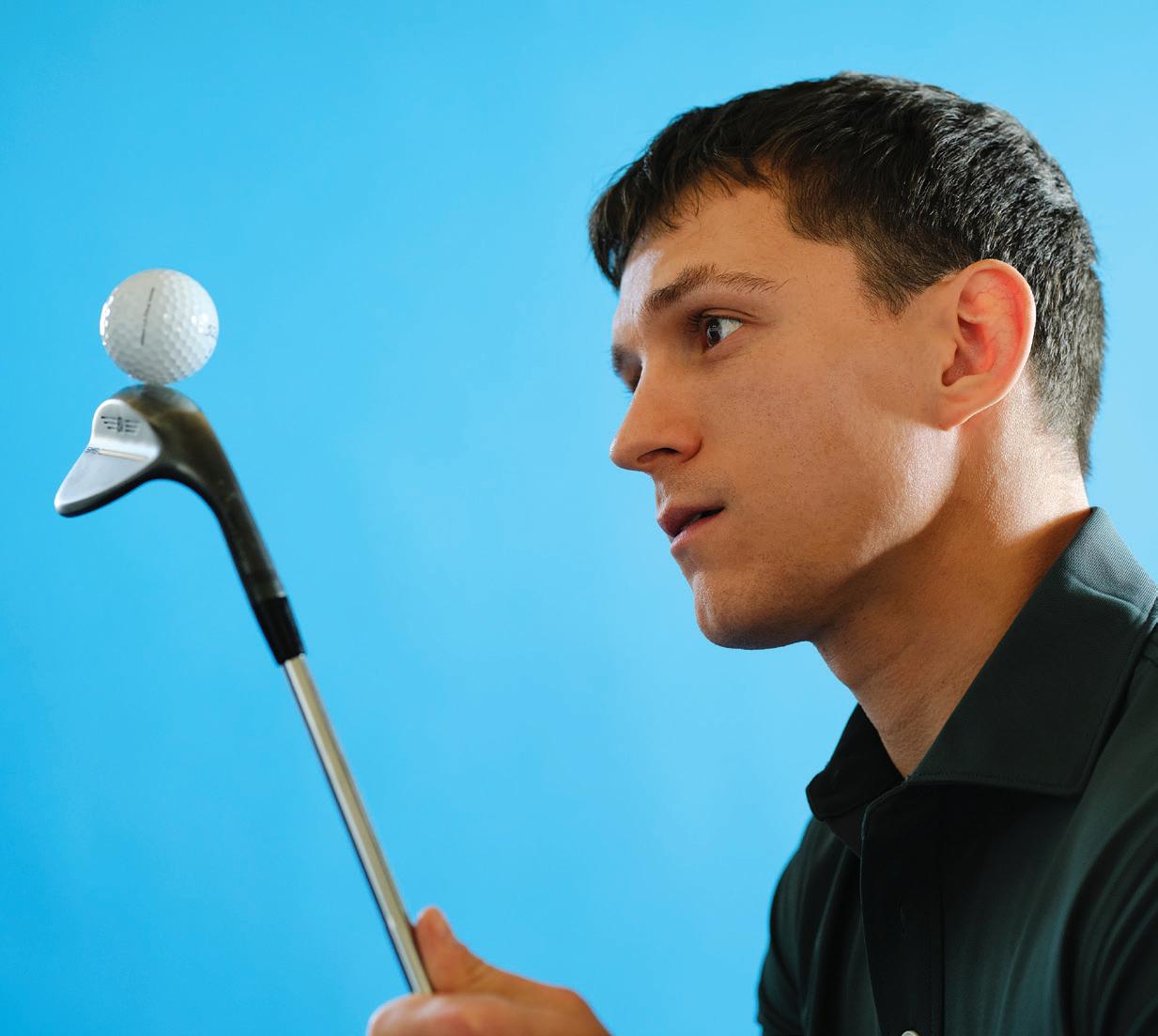
HAND-EYE Holland says his dancing background helped him cure a bout with the shanks.
As the story goes, a teenage Peter Parker acquires his superpowers after being bitten by a radioactive spider, but the current Spider-Man’s origin tale might be even more unlikely. Tom Holland was 10 when his hip-hop class performed at a dance festival, and he caught the eye of someone connected to the Royal Ballet School. That led to the British-born actor playing the title role in the West End production of “Billy Elliot” and, eventually, movie parts— including the role for which he’s most famous—followed.
“It’s so funny; I don’t know who that person is who spotted me that day,” Holland says. “I’ve never met them, and I owe my entire career to them.”
Now he’s one of the biggest stars in Hollywood with three Spider-Man movies bringing in a staggering $4 billion in box offices around the world with a fourth film in the series slated to be released in 2026. We caught up with Holland on a crisp fall day in New England, and it was easy to see why the leading man is also a leader in pro-ams around the world, like at last year’s BMW PGA Championship at Wentworth Golf Club, where he and younger brothers Harry and Sam teamed with Tommy Fleetwood to win. Holland was quick to note that Fleetwood did “a lot of the heavy lifting,” but Holland, who sports a 2.5 Handicap Index and a smooth and powerful swing, did make three consecutive birdies on his own ball. We should not be surprised, considering that the wiry 28-year-old does most of his own stunts on set.
Holland was a kid when his dad, Dominic, a comedian and author, introduced him to golf. Holland fell back in love with the game on the set of “Spider-Man: Far From Home” when he met crew member Alex Roberts. “Alex was the guy outside the clubhouse working as a carpenter and practicing his swing, just air swinging while wearing his drill and his hammer,” Holland recalls. “I introduced myself and then we started playing golf. Now me and my friends and his friends go on holiday three times a year together.”
Holland keeps his clubs with him on set and plays on his off days. He
loves the sport and competing— especially with his brothers—but it’s also an activity that makes sense given his job. “It’s irresponsible for me to play contact sports,” Holland says. “Everyone’s working on a job, and if I break my ankle, then the job has to shut down.” Not that he hasn’t gotten hurt on the course, like when Roberts, a scratch golfer, hit a ball off Holland’s head last year. Welts aside, Holland is thankful for the connections he’s made through the game.
“I think golf has been really helpful for me in terms of networking within the industry because it’s a very golfheavy business,” says Holland, who counts Marvel co-star Chris Pratt among his favourite playing partners. “I’ve actually got a deal point across in my contract playing golf. I met the producer I was negotiating with on a par 3. I stuck it closer than he did and won the deal point. It was something minor that we were fighting over, like agreeing to a driver or something like that.”
ting sober was a big reason why my handicap got better because I would go to bed early and would strive to wake up and shoot low scores. What used to happen to me is if I was playing badly, I would drink at the turn and then I would play worse, so I would drink more. Having cut that out has made for some more complete rounds.”
Holland only needed part of a round at the 2021 BMW PGA Championship pro-am to catch the attention of major champ Padraig Harrington. Faced with a 260-yard second shot over water on Wentworth’s finishing par 5, Holland hit a driver off the deck after getting Harrington to promise him a Ryder Cup captain’s pick if he knocked it on the green. Holland didn’t quite pull off the daring shot, but he still impressed Paddy.
“I think golf has been really helpful for me in terms of networking within the industry because it’s a very golf-heavy business.”
Golf has served as an escape from that industry and the spotlight. Holland and his fiancée and fellow Spider-Man co-star Zendaya, a two-time Emmy Award winner for her role in HBO’s “Euphoria,” make for one of the most famous celebrity couples on the planet. He says the paparazzi have gone as far as to hide in the bushes when he plays golf, but for the most part, the course is his place to “wind down.” It’s also been his preferred place to socialise, instead of Hollywood parties. Holland stopped drinking alcohol in January 2022 and launched a line of non-alcoholic beer, BERO, in late 2024.
“It definitely keeps me out of trouble,” Holland says of golf. “I think get-
Holland’s other on-course highlights include two holes-in-one, although he says “no one believed” the first, which came during a solo game. “I always say, ‘Look, I’m lucky enough that my life is really exciting. I don’t need to lie about getting a hole-in-one,’ ” Holland says with a laugh. “My second one I was playing in a match in Atlanta with the crew of Spider-Man 3. My brother was behind us. He was furious.”
For a superhero, Holland maintains a charming everyman quality. He laments that he bought his current set of irons just before a new model came out, and he hasn’t replaced a 3-wood that was damaged during travel. Holland admits to letting his temper get the best of him at times, saying, “I’ve done at least 14 clubs over my knee in my life.”
Holland is happy with the state of his game now, though. We witnessed him hit some booming drives as well as hole a birdie chip as he filmed an episode of “On the Tee” with Hally Leadbetter. That high level of play will be tougher to maintain in 2025, however, with Holland set to film a fourth Spider-Man movie as well as Christopher Nolan’s new blockbuster take on “The Odyssey.” “My game will take a hit, but I need to work, so it is what it is,” Holland says.
As Holland is well aware already, there’s no odyssey like the trials and tribulations a golfer goes through in life.
BY EDOARDO MOLINARI
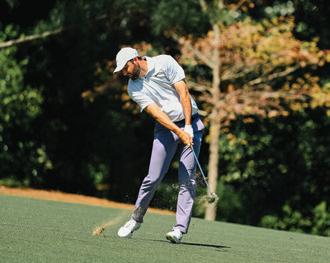
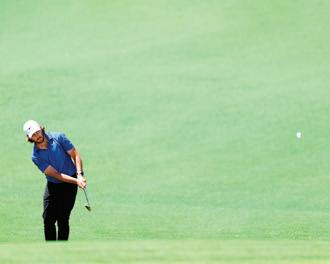
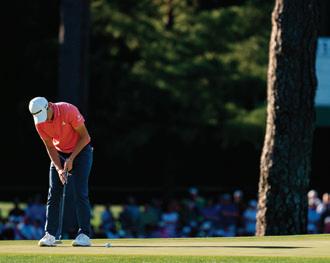
wh en the players I advise ask me what’s the key to winning at Augusta National, I always turn to three key statistics: approach play from 150 to 200 yards, chipping from the fairway and midrange putting between 15 and 30 feet. After studying the trends over recent years at the Masters and with the help of Arccos Pro Insights, here’s why these three areas are essential to success.
Approach play: At Augusta National, good approach play, especially from 150 to 200 yards, is rewarded the most. Almost 20 percent of shots gained overall by players that finish inside the top 20 are gained in this area, which is much higher than other courses. This is because the result between a good shot and a bad shot at Augusta is more drastic than at other courses.
Take the approach shot on the ninth hole, for example. When the pin is on the left side of the green, if you miss it in the left bunker, you have less than a 20-percent chance to get it up and down, while if you miss it right, you have more than an 80-percent chance to get it up and down. The difference between missing the green left or right is about 0.6 shots—and that’s just on one shot on one day. Players need to miss it in the right spots to play well at Augusta.
Chipping from the fairway: There is very little rough around most greens at Augusta National, so when you miss a green, you will often chip from the fairway cut. The data shows that players have three to four times more shots from the fairway around the greens at Augusta compared to other courses. A chip from the fairway is the most common short game shot on every hole except No. 12. For context, on the PGA Tour, players average less than two short game shots from the fairway each round, while at Augusta players will likely have more than five each round. Great chippers excel at Augusta because those players control the spin and trajectory of these shots around the treacherous greens.
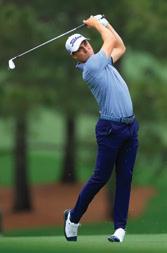
Midrange putting: Since the greens at Augusta National are sloped severely and the pins are often tucked, players will end up with a lot of putts from midrange. Holing a few of these 15 to 30 footers is key to playing well. Last year, nine out of the top 10 players on the leader board gained shots against the field on the greens, and eight of those players gained shots putting from 15 to 30 feet. There is a high correlation between how many shots players gain on the field from midrange putting and where they finish on the leader board.
EDOARDO MOLINARI, a former U.S. Amateur champion and three-time winner on the DP World Tour, is Arccos Golf’s Chief Data Strategist.
Aside from Scottie Scheffler, I look at Collin Morikawa and Tommy Fleetwood as likely contenders. Collin and Tommy can overcome their slight distance deficit with their elite approach play. Also, if Justin Thomas (pictured left) has a good week on the greens, look out. JT’s ball-striking has been great this year, and over the last few years he has been one of the best approach players on tour.
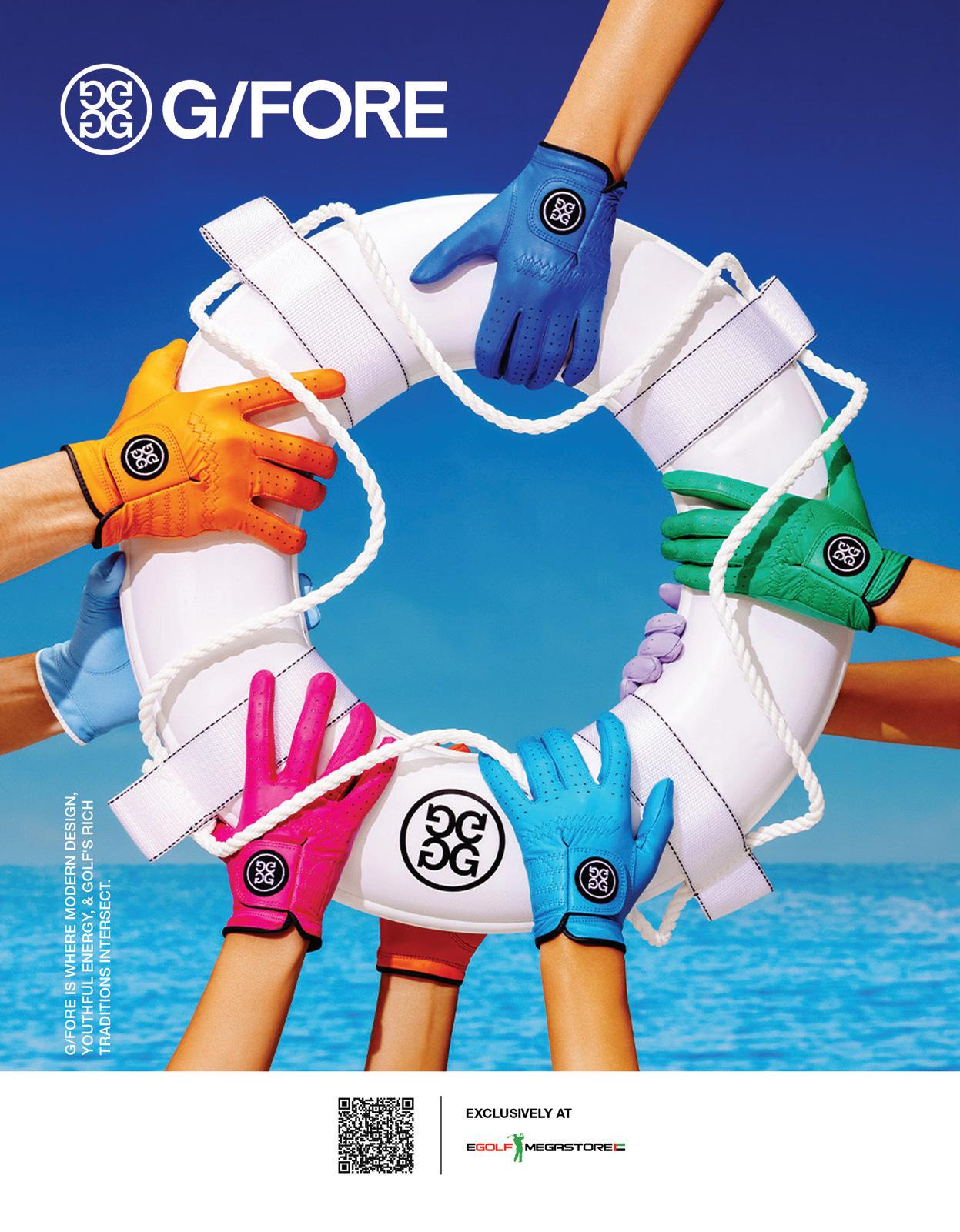
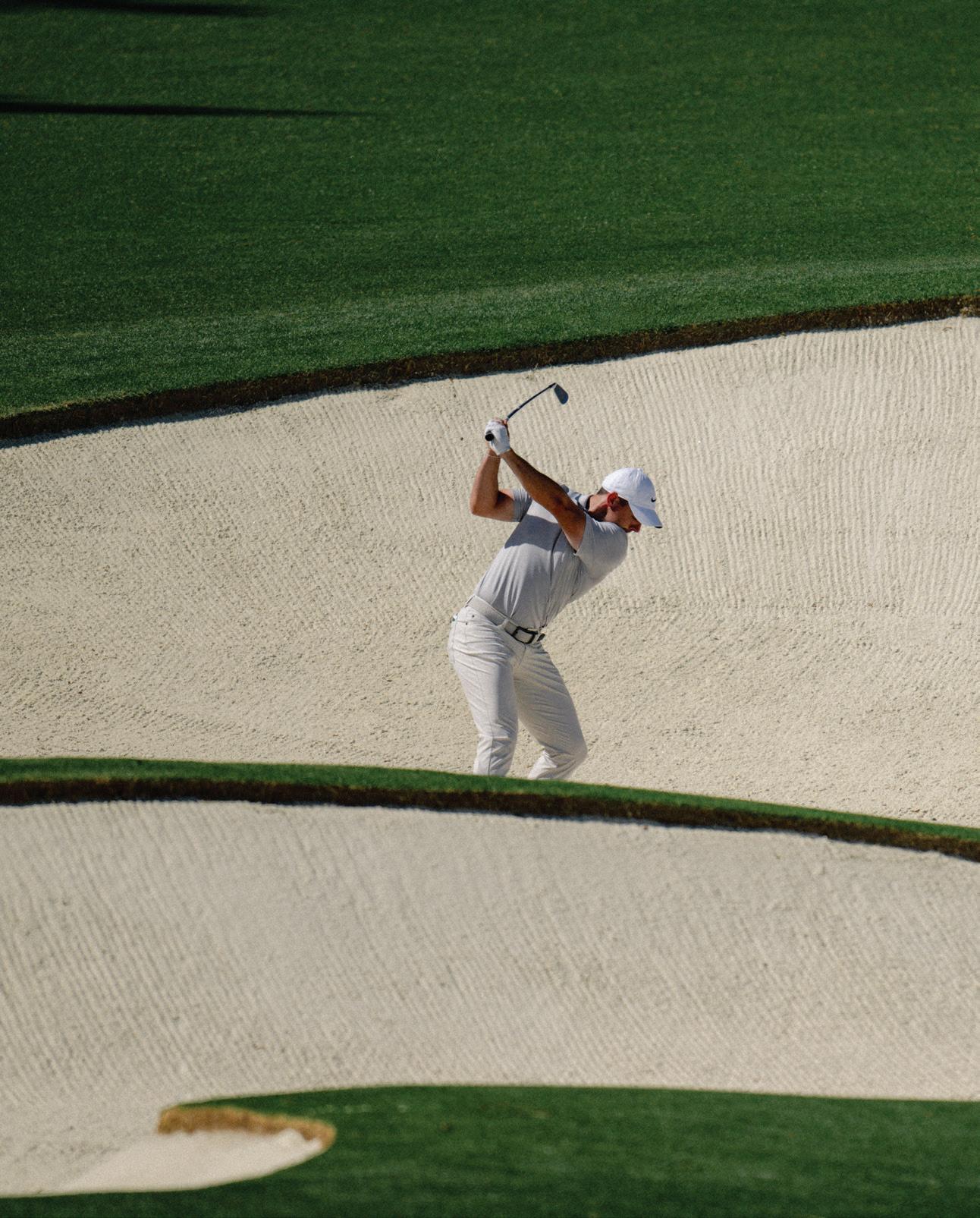
EDITED BY RON KASPRISKE
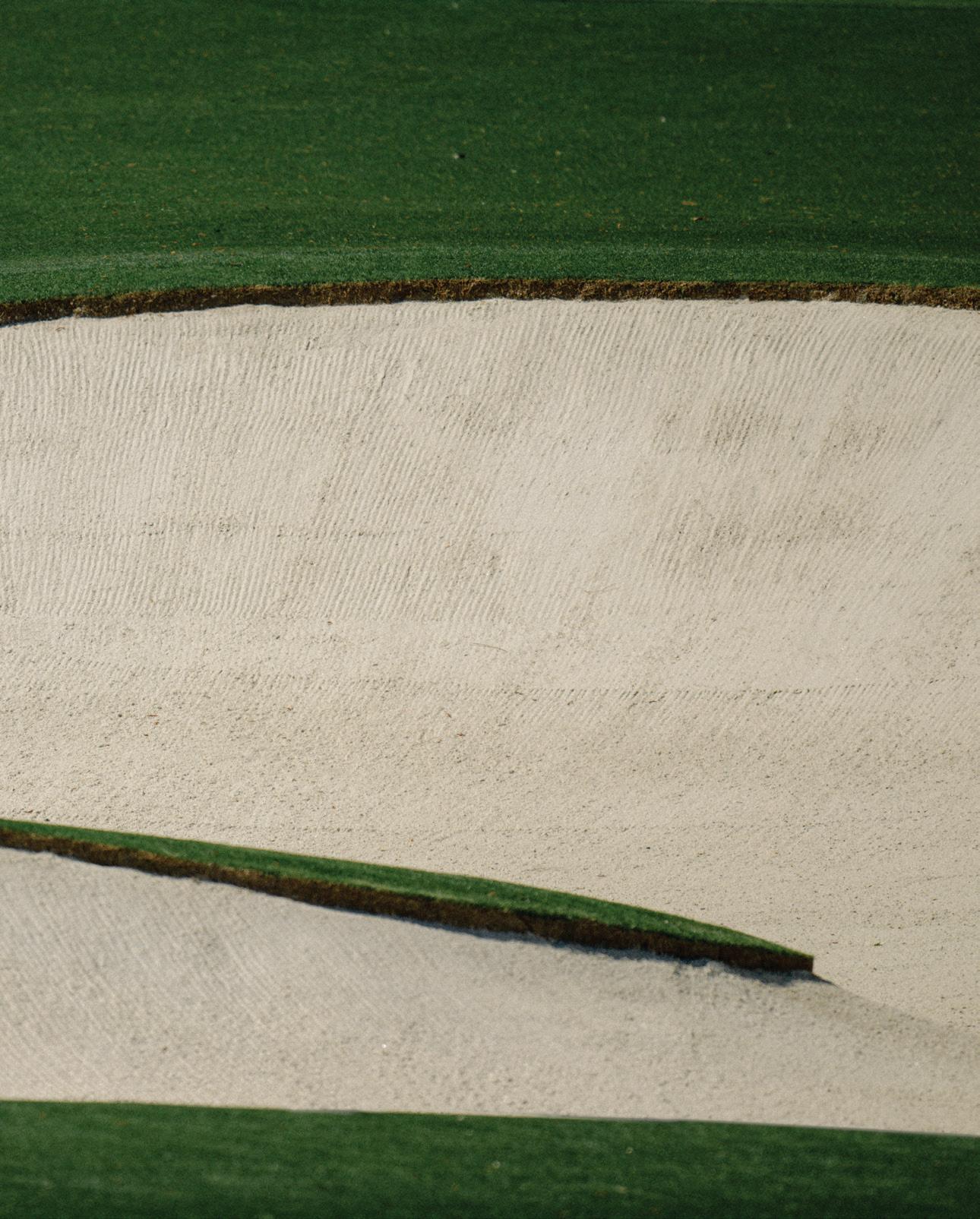
“This
golf course gets you to chase things a little more than other golf courses. If you make a bogey or if you get yourself out of position, it always tempts you to do something you think you can do. Sometimes, you just have to take the conservative route and be a little more disciplined and patient.”
— RORY MCILROY ON AUGUSTA NATIONAL (FOOD FOR THOUGHT FOR WHEREVER YOU PLAY, TOO).
No range time? No problem. The uber-talented Swede has a great way to practice your swing at home
BY DREW POWELL
GROWING UP, RISING
Swed ish golf star L udvig
Åberg had a powerful but notso-reliable swing because of a fault known as “early extension.” His hips would move toward the ball in the downswing and that forced him to alter his club’s path back to the ball. He’d try to save the shot with fast hand action to square the clubface, but when his timing was off, he’d hook it way off line.
“That’s still my tendency today. I get a little bit on the inside, and then I’ll just flip my hands,” he says.
To work on this issue, which also is a common one for amateur players, Åberg turned to an at-home drill: “During the wintertime when we were back home, I would be inside and I had a chair next to my butt, and I would always try to feel the pressure on the chair [as I swung],” he says.
On the backswing, Åberg would feel his right glute (butt) muscles press into the chair. As he started down, he would feel the left-side glutes stay back and push against the chair.
Doing this over and over reinforces the feeling that your hips should stay back as you swing, clearing room for you to slot your club’s path into the ball from inside the target line, he says. Do that, and there’s no need to hope you can square the clubface with your hands.
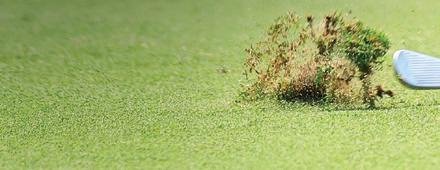
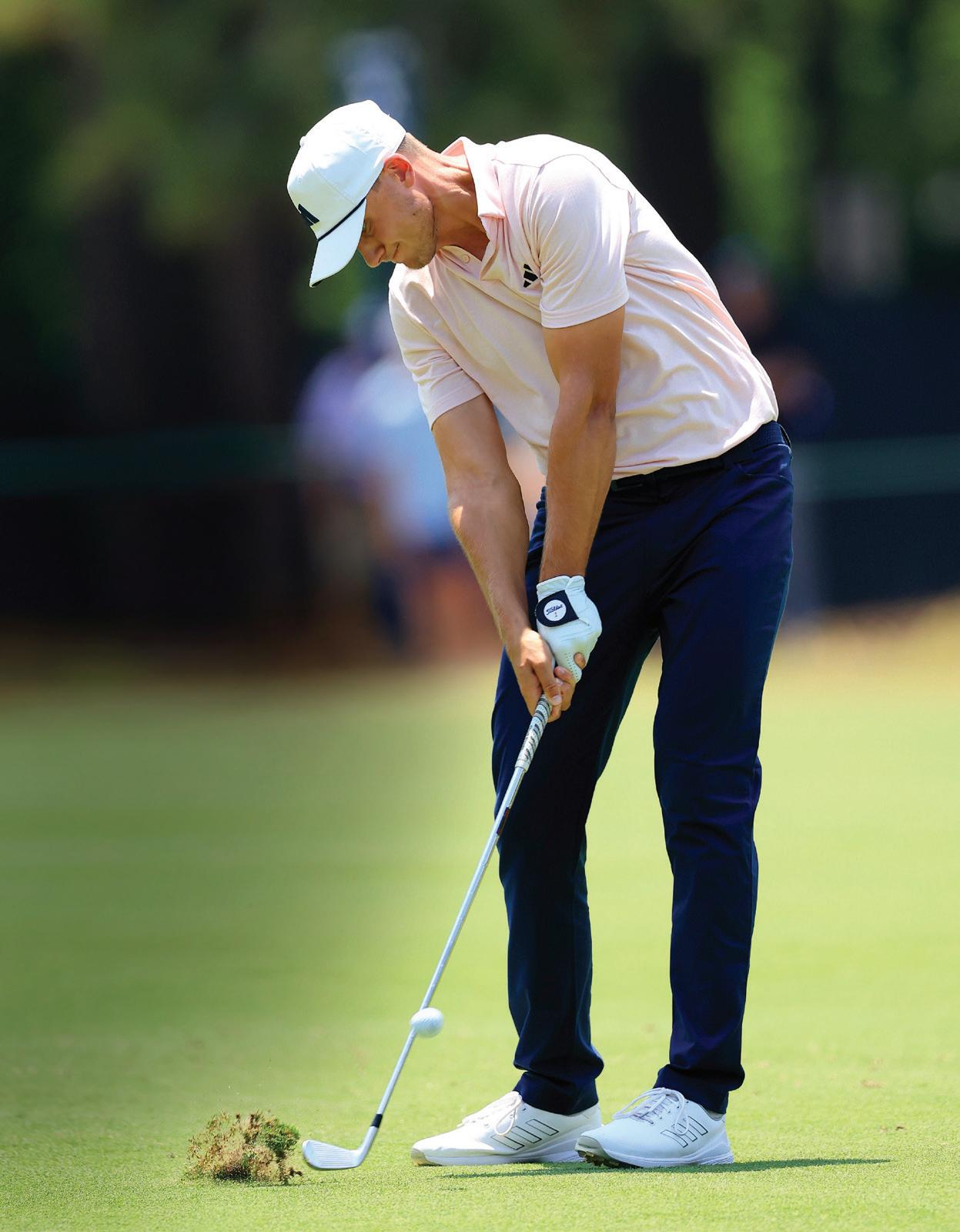





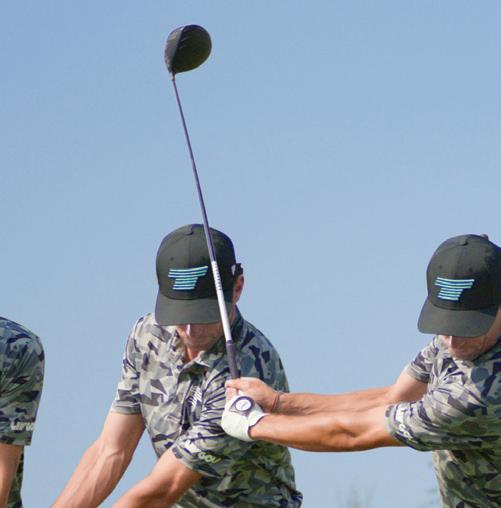


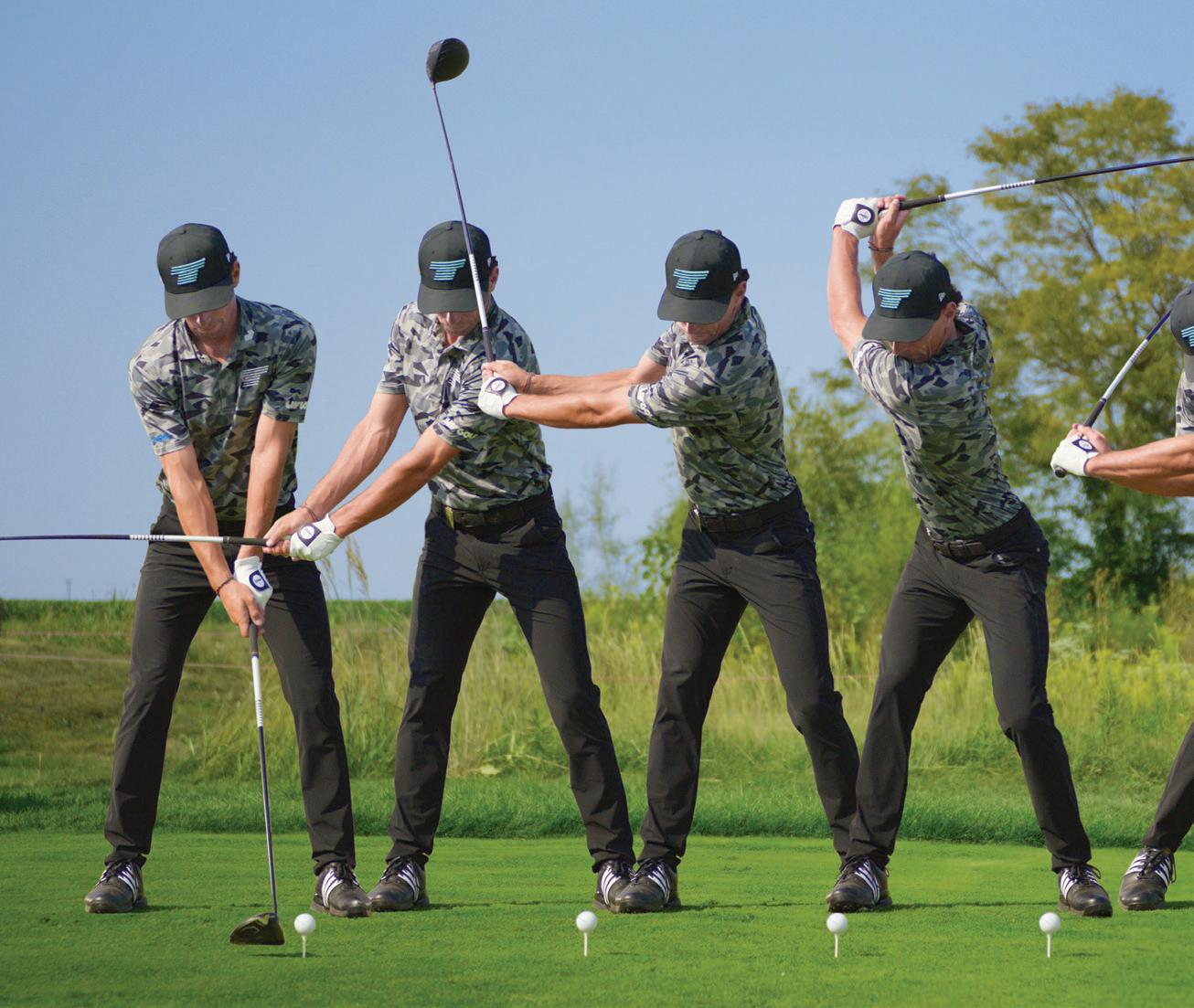
BY LUKE KERR-DINEEN
NO MOVE ACTIVATES THE multitude of armchair golf instructors on Instagram like Joaquin Niemann’s swing. It’s always the same thing that gets called out: In the milliseconds around impact, the 26-year-old Chilean drops his right shoulder and torso dramatically as he turns through (above, seventh photo). It gives his swing an extraordinary amount of side bend, which many pundits speculate is not a move that will hold up in the long term.
“I don’t really care what they say about it, to be honest,” says Niemann, who at 322.5 yards, ranked behind only Bryson
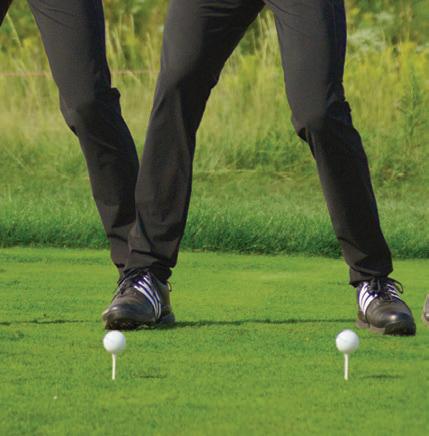
DeChambeau in average driving distance on the LIV Golf tour in 2024. “It always has felt natural to me. That’s just how my body works.”
You might think that the way Niemann’s spine is torqued in these photos, future injuries are inevitable. Not necessarily so, says Golf Digest 50 Best Teacher Jon Sinclair. His throughswing move might be a red flag for some, but others who have a similar movement pattern could be just fine.
“Some golfers are acutely strong, flexible or resilient in one or more areas of their body,” says Sinclair, an expert in 3-D motion capture and biomechanics.
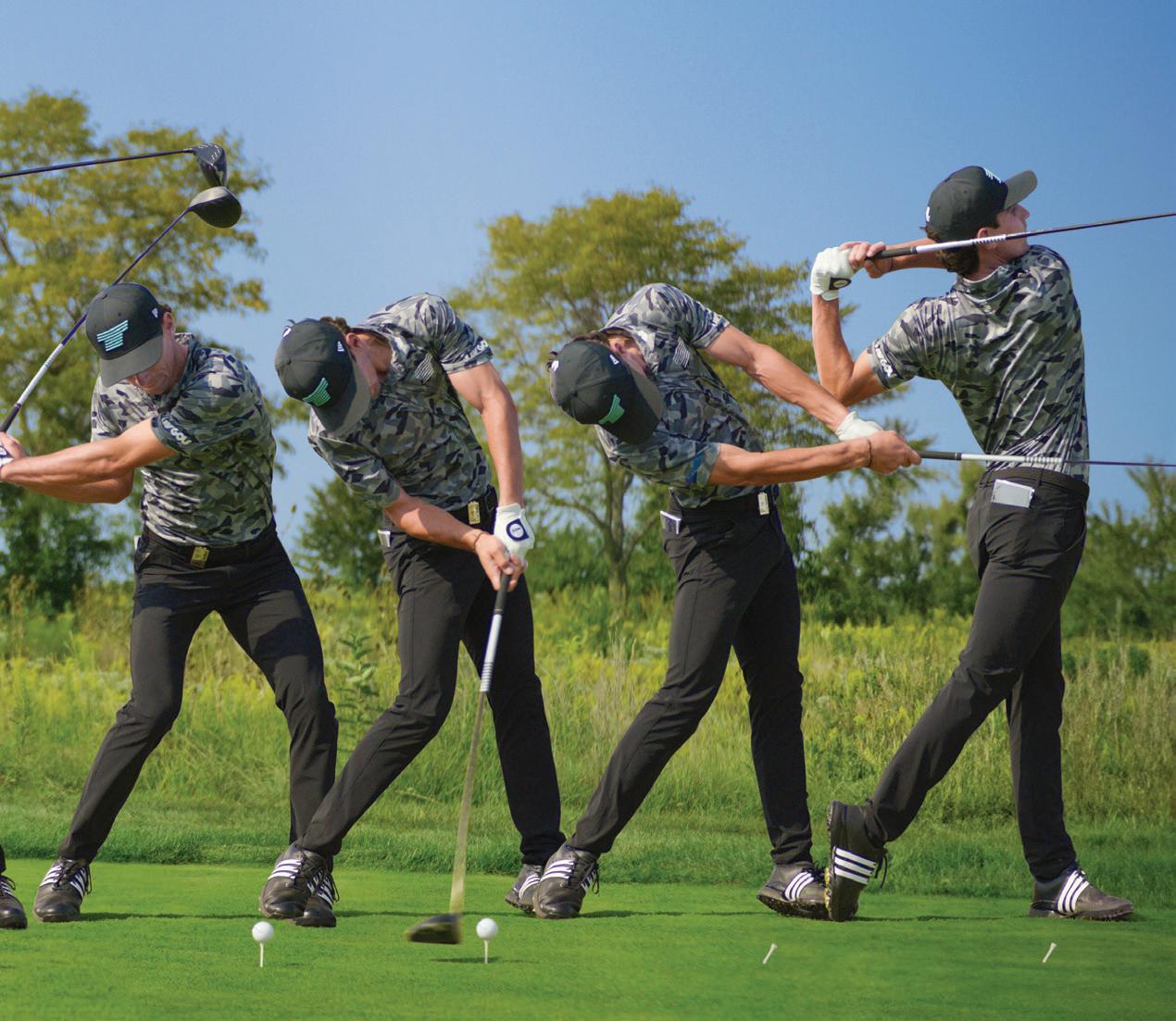
“What’s true for some is not true for all.”
Niemann, who ranked second on the LIV tour last year in greens in regulation (72.8 percent) and first in birdies, has become one of the best ball-strikers in pro golf. The downswing move certainly helps, but other parts of his swing should get some credit, too. Because he weighs only a shade over 150 pounds, he knew that the best way to maximise power was to make a big turn into his right side on the backswing (fourth photo). Niemann’s flexibility is on full display there, although he has to be careful not to overdo his turn.
“When I get lazy and stay on my right
A
Power up your backswing by copying Niemann’s move off the ball, his coach says.
side, it takes me a long time to get back to the ball,” Niemann says. “I can hit the ball chunky or left.”
The longtime coach of Niemann, fellow Chilean Eduardo Miquel, says average golfers can copy this part of Joaquin’s swing, making a wide turn off the ball and shifting into their trail side ( second photo ). That will boost your power. But rather than trying Niemann’s downswing, all you likely need to do to improve your ball-striking
is to focus on weight shift. Your weight needs to start moving toward the target as the club is finishing the backswing.
“This [shift] will help you rotate through correctly,” Miquel says.
Niemann adds that it’s also important to keep your chest down when you swing through. If your chest lifts up too soon, your body stops turning and your hands take over, making it a lot harder to control the clubface without perfect timing.
“Ever since I was young, I was trying to turn my body,” Niemann says. “Staying down is the way you can naturally turn the most.”






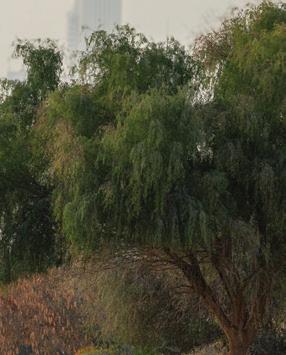

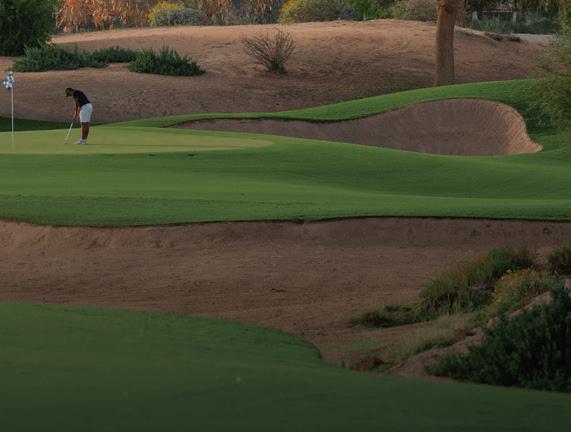




L.A.B. Golf, the fastest-growing putter company, stands at the forefront of “low-torque” or “zero-torque” putters, and many are following its lead, including putter giant Odyssey with its new Square 2 Square models. Even L.A.B. Golf has gone a little mainstream with its new Oz.1i model (above) and its classic clamshell shape. L.A.B.’s low-torque idea, designed to reduce the role of the hands during the stroke, got its start in 2016 when teaching pro Bill Presse produced the Directed Force putter (right), a model that Hot List testers at the time said “almost swings itself.” The branding iron look may not have been an instant hit, but the message behind it has become a force all its own.
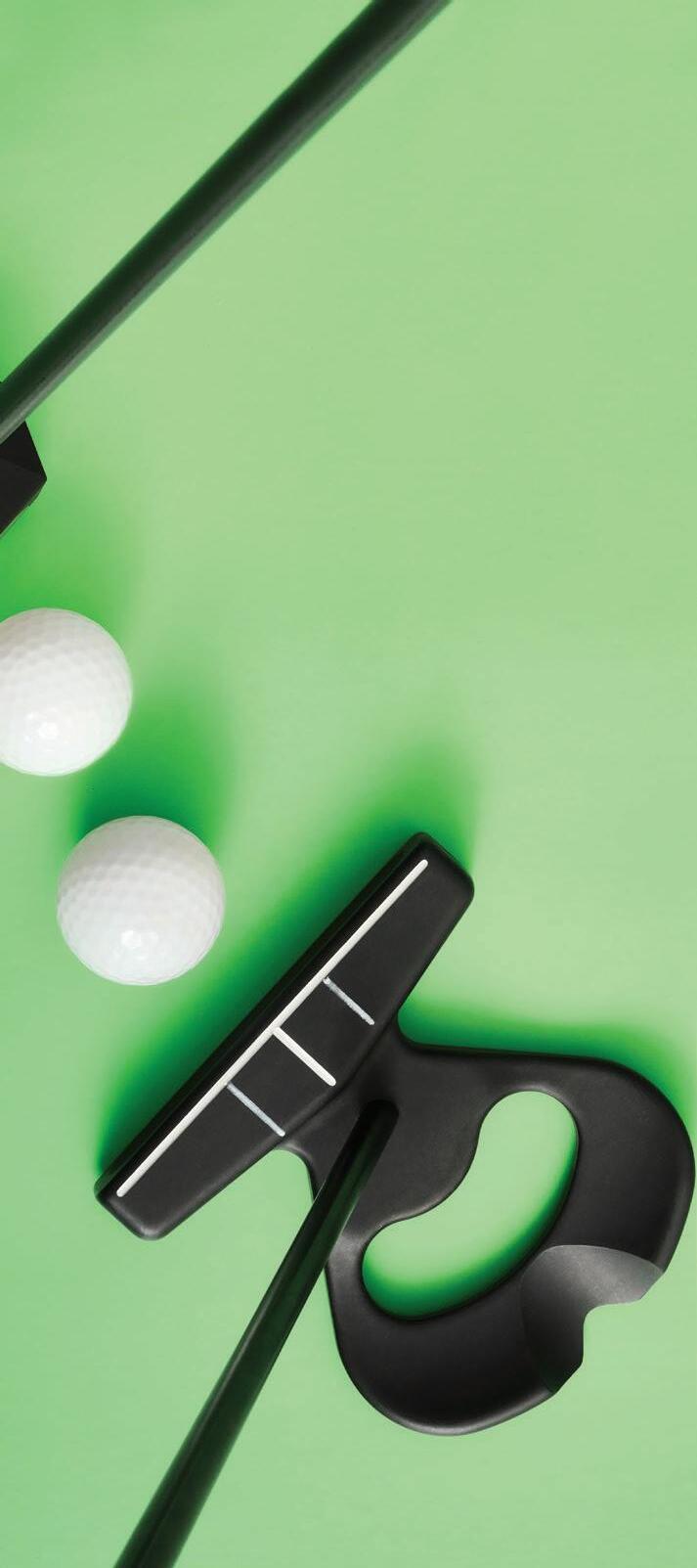
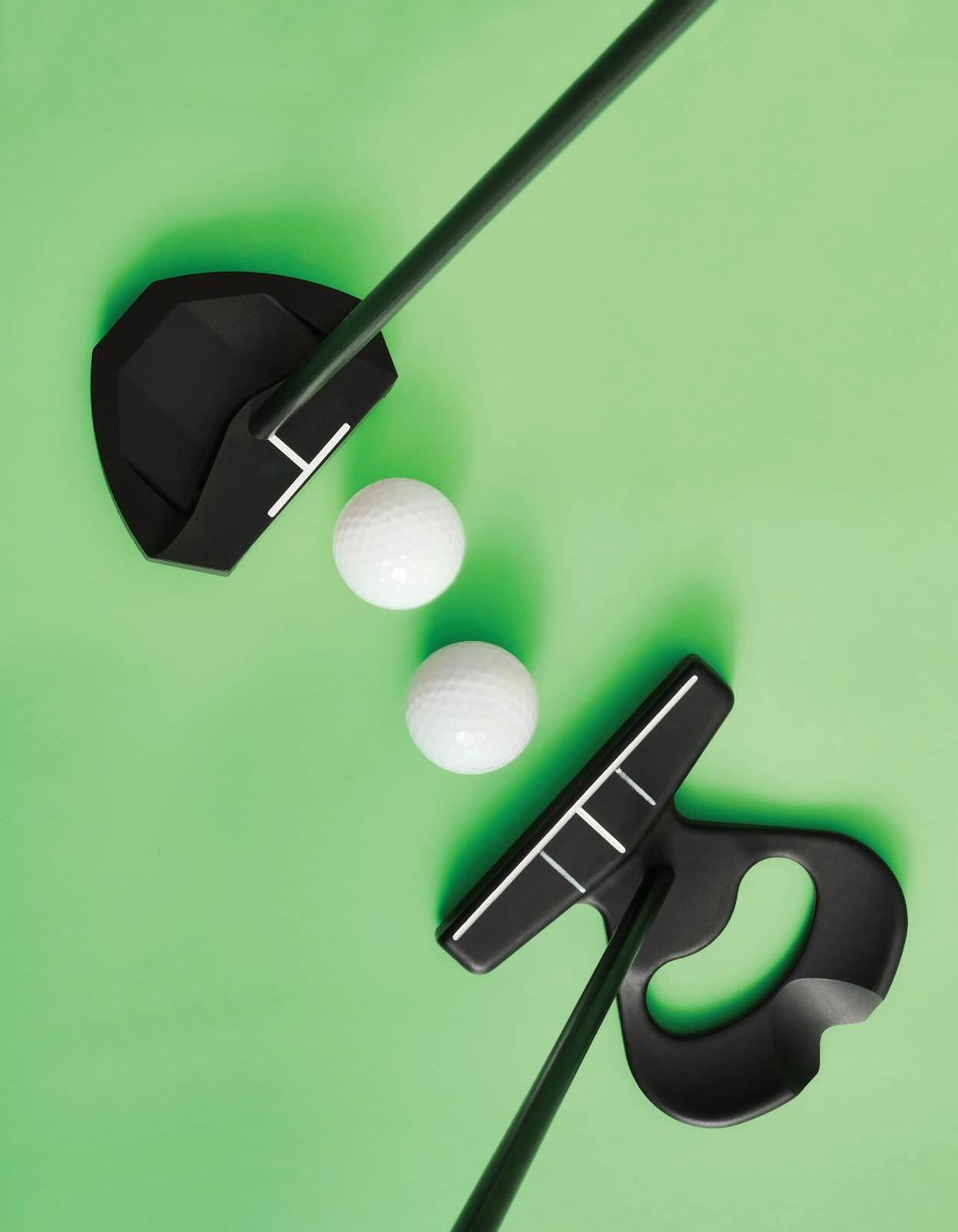






























































The best fairway woods and hybrids embrace a remarkable diversity of shapes, sizes and materials. It’s all in search of providing assistance for elite and average golfers on some of the most intimidating shots they face. But that intimidation might not be what it once was. Lower centres of gravity, hotter clubfaces and more effective sole designs now give a wider range of players confidence that a 200-plus-yard shot off a tight lie or an even tighter driving hole is no cause for panic.


• An internal-weighting structure (a 31-gram tungsten bar sits low and forward) reduces spin and allows the lower part of the clubface to flex like the centre.
• An AI-driven clubface design optimises launch and spin and increases ball speed.
• The sole geometry’s
extensive relief on the back half reduces the contact area by almost 60 percent.
• Top 5 in Performance, low- and high-handicaps
• 15, 16.5, 18, 20, 21, 24, 27 degrees (adjustable hosel on the 15-, 16.5-degree)
Demo this club and get a custom fit at eGolf Megastore






RRP AED 1,895

























‘Face is hot. Comes right off the club and goes to work. —6-HANDICAP













• The compact shape targets high-skilled players seeking lower spin and launch.
• A fixed weight screw lowers the centre of gravity and maintains a neutral ball flight.
• A 31-gram tungsten bar positioned low and forward reduces spin and frees up the lower portion of the face to flex with the
• The lighter overall weight targets players with moderate swing speeds looking for a higher launch and a draw bias.
same potential ball speed as the center.
• Callaway used AIdriven algorithms to develop a variablethickness face.
• The sole’s stepped design features extensive relief for improved turf interaction.
• 15, 18, 21 degrees (adjustable hosel on the 15-degree)
RRP AED 1,895



• A high-strength steel-alloy face insert wraps around the crown and sole to promote faster ball speeds.
• A carbon-composite crown lowers the centre of gravity and provides mass for perimeter weighting.
• 16, 19, 22, 25 degrees (fixed hosel)
• A 31-gram tungsten bar positioned low and forward reduces spin and frees up the lower portion of the face to flex with the same potential ball speed as the centre.
Demo this club and get a custom fit at eGolf Megastore













‘From a forgiveness standpoint, it felt like it had guardrails.’ —10-HANDICAP


RRP AED 2,195










‘The club basically swings itself. Highlaunching.’ —0-HANDICAP




• Slightly larger than the standard model, the Elyte X focuses on forgiveness, higher launch and slice-fighting.
• A 31-gram tungsten bar positioned low and forward reduces spin and frees up the lower portion of the face to flex with the same potential ball speed as the centre.
• A high-strength steel face insert wraps around the crown and sole for better overall ball speeds.
• Callaway used AIdriven algorithms to develop a variablethickness face.
• Top 5 in Forgiveness, middle-handicaps
• 15, 16.5, 18, 21 degrees (adjustable hosel on the 15-, 16.5-degree)
Demo this club and get a custom fit at eGolf Megastore





RRP AED 1,895



















‘It’s long and forgiving like a driver but still very workable.’









• The use of multiple materials, including a more resilient titanium clubface, make this Callaway’s lowest-spinning fairway wood.
• A 70-gram tungsten bar (more than four times the mass used in last year’s Ai Smoke) is located very low and forward, pushing
the centre of gravity lower while allowing the face to flex.
• Adjustable sole weights boost launch or reduce spin.
• Top 5 in Performance, middle-handicaps
• 15, 16.5, 18 degrees (eight-way adjustable hosel)

—13-HANDICAP



Demo
• The most compact fairway wood in the company’s lineup, its hot titanium clubface favours better players looking to lower spin.
• Internal tungsten weighting surrounds the weight ports in the sole, moving the centre of gravity low and forward so that shots launch with less spin.
• The adjustable hosel’s 33 settings tweak ball flight low, high, left or right to match player preferences.
• Top 5 in Performance, low-handicaps
• 14.5, 16, 17 degrees (33-way adjustable hosel)
Demo this club and get a custom fit at eGolf Megastore
RRP AED 1,995














‘As forgiving as my mother. Barely lost any distance and stayed on target.’
—6-HANDICAP

RRP AED 2,395









‘A winner in the look at address and the scored silver grooves.’
—5-HANDICAP

• This mid-size model caters to players looking for lower spin and greater forgiveness.
• A carbon-composite crown—the thinnest in the company’s history—lowers the centre of gravity and bolsters the perimeter for greater stability on o -center hits.
• An internal bridgelike weight close to the face and slightly above the sole provides a distance boost through a low, forward centre of gravity.
• Top 5 in Sound/Feel, low-handicaps
• 15, 16.5, 18, 21 degrees (33-way adjustable hosel)
Demo this club and get a custom fit at eGolf Megastore



RRP AED 1,675


















‘Medium launch that rarely changed. Even weak misses rewarded.’

—9-HANDICAP



• Better players with faster swing speeds will benefit the most from this design.
• A carbon-composite piece wraps around the back of the crown, saving weight to lower the centre of gravity for less spin.


• The largest head in the DS-Adapt lineup favors players looking for forgiveness and slice-correction.
• A carbon-composite crown—the thinnest in the company’s history—saves mass that’s relocated low and in the heel.
• Two movable sole weights (13 and three
grams) in the heel and centre allow players to favor forgiveness or draw bias.
• The weaker lofts and the 9-wood model are easier to launch for players with only moderate swing speeds.
• 15.5, 18.5, 21.5, 24.5 degrees (33-way adjustable hosel)
Demo this club and get a custom fit at eGolf Megastore
RRP AED 1,995

• A redesigned interior section of the hosel frees up room for the heel side of the face to flex more e ciently.
• Top 5 in Performance, low-handicaps
• 15, 19 degrees (eight-way adjustable hosel)
• An 85-gram tungsten sole plate (6 percent heavier than last year’s model) also serves to keep the centre of gravity low.
Demo this club and get a custom fit at eGolf Megastore










‘Looks great behind the ball, nothing distracting.’
—14-HANDICAP

RRP AED 1,675









‘It’s like putting a club on autoplay. The easier I swing it, the better it performs.’ —+3-HANDICAP




• The taller face yields more ball speed across the face, particularly on tee shots.
• A redesigned interior section of the hosel frees up room for the heel side of the face to flex more e ciently.
• The high-strength steel alloy wraps around the crown and sole for greater
rebound on mis-hits.
• A slimmer rear weight ensures the club rests closer to the ground for a consistent face angle regardless of the adjustable loft and lie settings.
• 15, 17, 19, 21, 24 degrees (eight-way adjustable hosel)
Demo this club and get a custom fit at eGolf Megastore



RRP AED 1,995
















‘Get a sense that its sole purpose is to get the ball in the air, which it does.’

—0-HANDICAP





• Targets golfers with average to aboveaverage swing speeds looking for consistent distance and fitting options through an adjustable hosel.
• A lower profile than last year’s Qi10 increases the likelihood of centreface contact and provides a sleeker
• With the shallowest face height in Ping’s lineup, this model targets players who use fairway woods o the ground and not the tee.
• The high-strength steel alloy wraps around the crown and sole for greater rebound on mis-hits.
• Extra loft on the 3and 7-woods and a
shorter shaft length on the 5-wood help golfers with average to below-average swing speeds launch shots higher.
• A more open interior hosel section frees up room for the heel side of the clubface to flex more e ciently.
• 16, 19, 22 degrees (adjustable hosel)
Demo this club and get a custom fit at eGolf Megastore
look at address.
• The company’s trademark slot in the sole stretches longer into the toe to create a more flexible face.
• Top 5 in Performance, high-handicaps
• 15, 16.5, 18, 21 degrees (12-way adjustable hosel)
Demo this club and get a custom fit at eGolf Megastore
RRP AED 1,695











‘Love that there’s no appearance of other materials besides the carbon composite.’
—13-HANDICAP

RRP AED 1,995









‘Turned into an absolute stripe show. High, long, powerful, forgiving.’
—7-HANDICAP

• With its large address profile, shallow face, deep frontto-back size and slightly weaker lofts, this model targets players looking for easier launch and forgiveness on o -centre hits.
• A built-in draw bias looks to o set the miss of the typical golfer.
• Lightweight carbon composite covers nearly the entire crown to lower the centre of gravity for higher launch with less spin.
• Top 5 in Forgiveness, middle-handicaps
• 15.5, 18.5, 21.5, 24.5 degrees (adjustable hosel)
Demo this club and get a custom fit at eGolf Megastore



RRP AED 1,695
















‘I could see the average person loving this 3-wood because of the lighter head.’

—0-HANDICAP





• Built on the same platform as the oversized Qi35 Max, the lighter overall weight favours golfers with moderate swing speeds looking to launch the ball higher.
• A draw bias works to o set the miss of the typical golfer.
• The company’s
• The taller face height targets players seeking maximum ball speed and extremely low spin.
• A sliding sole weight shifts the centre of gravity from front to back to control spin.
• The 40-gram weight is heavier on one side for a wider range of centre-of-gravity settings and less spin
versus the Qi10 Tour.
• The slot in the sole stretches longer into the toe to create a broader flexible area.
• Top 5 in Performance, middle- and high-handicaps
• 15, 18, 21 degrees (12-way adjustable hosel)
Demo this club and get a custom fit at eGolf Megastore
trademark slot in the sole stretches longer into the toe to create a more flexible face, especially for lower impacts.
• With the adjustable hosel, the loft range stretches from 13.5 to 23.5 degrees.
• 15.5, 18.5, 21.5 degrees (adjustable hosel)
RRP AED 2,195











‘You can tell they’re trying to pull loads of weight to the rear of the head.’
—1-HANDICAP










‘Looks like an Infiniti Q80. Good launch without getting floaty.’
—6-HANDICAP




• Built for golfers with moderate swing speeds, this lighter design combines higher launch with increased stability.
• A deeper centre of gravity (deepest in the GT lineup) fuels that enhanced stability.
• The shallower face instills confidence in golfers who struggle
to get the ball in the air.
• Front and rear sole weights (11 and three grams) emphasise higher launch and forgiveness or high launch and lower spin.
• 15, 18, 21, 24 degrees (adjustable hosel)
Demo this club and get a custom fit at eGolf Megastore



RRP AED 1,995













‘I really like the overall shape. There is no garishness involved.’




—13-HANDICAP



• This model has a taller face height and creates a flatter ball flight than the GT2.
• Targets golfers who hit down on the ball and use a 3-wood primarily o the tee.
• The adjustable weight track distributes mass in one of five spots heel to toe to better fit a player’s


• Targeting golfers with average to above-average swing speeds, the GT2 is larger than the GT3 and emphasises forgiveness and higher launch.
• Features a new thermoplasticpolymer-matrix crown that weighs one-fifth as much as the surrounding steel
to push the centre of gravity lower and more forward.
• The high-strength steel-alloy face bends around the sole for better lowface flex.
• Top 5 in Performance, middleand high-handicaps
• 13.5, 15, 16.5, 18, 21 degrees (16-way adjustable hosel)
Demo this club and get a custom fit at eGolf Megastore
flight preferences or typical impact locations.
• Features a new thermoplasticpolymer-matrix crown that weighs one-fifth as much as the surrounding steel.
• Top 5 in Look, low-handicaps
• 15, 16.5, 18 degrees (adjustable hosel)
Demo this club and get a custom fit at eGolf Megastore
RRP AED 1,995











‘Even Homer Simpson could find success with this. It’s dummy proof: point, click and shoot.’
—8-HANDICAP

RRP AED 1,995









‘Compact head with a deeper face is a plus. The adjustability keeps spin down.’
—1-HANDICAP

• Better players will find its compact size and emphasis on low spin appealing.
• The all-titanium body includes a high-strength, betatitanium alloy in the face designed with variable thickness to maximise oncentre and o -centre ball speed.
• A steel bar within the
slot’s polymer filling shifts the centre of gravity forward to reduce spin.
• The 80-gram steel soleplate further lowers the centre of gravity to yield higher launch with less spin.
• 15, 18 degrees (eight-way adjustable hosel)
Demo this club and get a custom fit at eGolf Megastore



RRP AED 1,595















‘The first word that comes to mind is powerful. Off the tee, it flies high, straight and far.’

—10-HANDICAP



• This historically better players’ fairway wood expands its size and interior weighting to increase playability for a broader range of golfers.
• The new design mixes a thinner centre-face section with thick regions in the heel and toe to improve distance.


• The club’s low profile should appeal to those eager to tweak ball flight with an adjustable hosel and three movable sole weights.
• This model is more forgiving than in past years and features a spin-reducing forward centre of gravity.
• The high-strength
steel face insert is 12.5-percent thinner than previous versions, creating more rebound and saving mass.
• Top 5 in Performance, middle-handicaps
• 15, 17, 18, 21, 24 degrees (eight-way adjustable hosel)
Demo this club and get a custom fit at eGolf Megastore
• Rigid and flexible zones in the crown and sole increase flexibility.
• An angled feature in the internal weighting keeps mass low while allowing room for increased flexing.
• 13.5, 15, 18, 21 degrees (12-way adjustable hosel)
Demo this club and get a custom fit at eGolf Megastore
RRP AED 1,795













‘It looks very high-end. The sound, feel and performance were exactly what I was looking for.’
—0-HANDICAP

RRP AED 1,995










‘Incredible speed off any location on the face.’
—5-HANDICAP




• This new edition maximises distance for average golfers through adjustability and lie angle.
• After researching thousands of average-golfer swings, Callaway concluded that the proper lie angle was crucial to better contact with hybrids, hence the reason for
the new emphasis on optimising it.
• The adjustable hosel tweaks lie angle by up to 2 degrees.
• The mid-size profile eases the transition from irons.
• Top 5 in Performance, high-handicaps
• 19, 22, 26, 30 degrees (seven-way adjustable hosel)
Demo this club and get a custom fit at eGolf Megastore



RRP AED 1,595
















‘Felt as forgiving as a fairway wood and so easy through the turf. No trouble launching these.’

—13-HANDICAP





• This model seeks to maximise distance for average golfers through adjustability and lie angle.
• The oversized profile provides stability on mis-hits for more consistent distance.
• A slight draw bias o sets the tendency of most golfers to slice low-lofted clubs.
• The larger profile and shallower face foster confidence in average golfers looking for more forgiveness and easier launch.
• A slight draw bias on the lower-lofted clubs works to o set the common slice tendency.
• The lighter weight is designed for
moderate-swingspeed players.
• Weaker lofts aid launch for players with below-average speed.
• Best option for golfers who fit into Callaway’s Elyte Max Fast iron.
• 23, 27, 31, 35, 39 degrees (seven-way adjustable hosel)
Demo this club and get a custom fit at eGolf Megastore
• These strongestlofted hybrids in the lineup boost ball speed.
• The adjustable hosel features up to 2 degrees of adjustment for lie, a key to better contact with hybrids, per Callaway research.
• 18, 21, 25, 29 degrees (seven-way adjustable hosel)
Demo this club and get a custom fit at eGolf Megastore
RRP AED 1,595








LAUNCH



‘Delivers a nice, rising launch with terrific distance and plenty of stopping power.’
—13-HANDICAP










‘Distance stood out. A hybrid that lives on the frontier with fairway woods.’
—11-HANDICAP

• With a focus on forgiveness, this larger model is the highest launching of Cobra’s hybrids.
• A bridge-like structure inside the front of the head attaches to internal heel and toe weight pads to push the centre of gravity low and forward for better energy
transfer.
• The face is designed with variable thicknesses in 15 distinct regions for more consistency across the face.
• Top 5 in Look, middle-handicaps
• 17, 19, 21, 24, 28 degrees (33-way adjustable hosel)
Demo this club and get a custom fit at eGolf Megastore



RRP AED 1,275
















‘The small profile can be intimidating, but it packs a wallop. Powerful, penetrating flight.’

—7-HANDICAP





• The L-shaped face insert wraps around the leading edge and into the sole to maximise rebound, particularly on impacts low on the clubface.
• A thin carboncomposite crown comprises just one percent of the head’s weight and saves mass that’s
redistributed low and on the perimeter for forgiveness and less spin, plus heel and toe sole weights enhance workability.
• Top 5 in Performance, low-handicaps
• 17, 19, 22, 25 degrees; one-length in 19, 21, 24 degrees (33-way adjustable hosel)
Coming soon to eGolf Megastore
G440 RRP AED 1,695
• Ping lowered the clubface height by 8 percent and made the face thinner. This encourages hotter centre-face contact for optimal launch and more ball speed.
• A more open interior hosel section saves mass that lowers the centre of gravity by 12 percent for higher launch and less spin.
• A carbon-composite piece wraps around the crown to save mass for a deeper, more forgiving centre of gravity.
• Top 5 in Performance, low-, middle-, high-handicaps
• 17, 20, 23, 26, 30, 34 degrees (eight-way adjustable hosel)
Demo this club and get a custom fit at eGolf Megastore








LAUNCH



‘Doesn’t compromise on forgiveness. Mis-hits still stayed in the park.’
—13-HANDICAP

RRP TBC









‘Nuclear explosive. The ball jumps off the face and is gone in a flash.’
—15-HANDICAP




• Srixon’s hybrids now feature a larger size and hosel adjustability to fit a wider variety of swings and skills.
• By varying rigid and flexible layers in the face and crown, these hybrids get additional speed from the flexing of the crown at impact.
• The increased volume (as much as 11 percent bigger) and larger areas in the toe and back provide increased stability on o -centre strikes.
• Top 5 in Look, high-handicaps
• 17, 19, 22, 25, 28 degrees (12-way adjustable hosel)
Demo this club and get a custom fit at eGolf Megastore



RRP AED 1,495
















‘Love the blend of carbon fiber and gunmetal. Beautiful feel and performance.’

—14-HANDICAP





• Built to fit the broadest range of player types, the standard Qi35 now straddles the line between the previous Qi10 and Qi10 Tour models.
• The Qi35 boasts a similar shape to the Qi10 but with a slightly more forward centre of gravity for lower spin and better energy transfer.
• A sole slot improves the way the face flexes, especially for impacts below the centre of the face.
• Top 5 in Performance, middle- and high-handicaps
• 17, 19, 22, 25 degrees (12-way adjustable hosel)
Demo this club and get a custom fit at eGolf Megastore
• The oversized shape emphasises forgiveness and a higher launch with more of a draw bias than the Qi35.
• The weight screw in the back-centre of the sole deepens the centre of gravity for more forgiveness.
• A carbon-composite crown lowers the centre of gravity.
• Lofts are stronger than Qi10 Max for less spin and more ball speed.
• Lie angles are slightly more upright than in the standard Qi35 to minimise a slice.
• Top 5 in Performance, high-handicaps
• 20, 23, 27, 31, 35 degrees (fixed hosel)
Demo this club and get a custom fit at eGolf Megastore
RRP AED 1,495











‘Just set it down, and it’ll do the rest. Automatic medium-tolow flight.’
—7-HANDICAP

RRP AED 1,495









‘The ball flight had a nice, long rise to its apex and then dropped right on top of its target.’
—11-HANDICAP

• Oversized like the Max, but it has a more tip-flexible shaft. It also weighs significantly less to help golfers with moderate swing speeds launch shots higher.
• The weight screw in the back-centre of the sole deepens the centre of gravity for more forgiveness.
• A carbon-composite crown lowers the centre of gravity.
• Lie angles are slightly more upright than in the standard Qi35 for help against slicing.
• 23, 27, 31, 35 degrees (fixed hosel)
RRP AED 1,495








Demo this club and get a custom fit at eGolf Megastore










‘It’s easy to launch and very forgiving. Missed shots sacrificed some distance but still went straight.’

—5-HANDICAP



• Designed to provide maximum forgiveness to players with average to above-average swing speeds.


• This wood-like hybrid is Titleist’s most forgiving, targeting players looking for a higher launch.
• It has the deepest centre of gravity in the lineup for more stability and a higher launch angle.
• Movable weights in the front of the sole and rear perimeter allow players to tweak
launch or lower spin.
• The fairway-woodstyle shaft also helps to optimise launch.
• The larger face (than the TSR1) extends the degree of forgiveness.
• Top 5 in Performance, middleand high-handicaps
• 20, 23, 26, 29 degrees (adjustable hosel)
Demo this club and get a custom fit at eGolf Megastore
• Adjustable heel and toe weights in the sole control draw or fade trajectories and dial in the best energy transfer for where players tend to contact the clubface.
• Flatter leading edge increases hittable area low on the face, where most impacts occur.
• Higher launching with added forgiveness on heel and toe mis-hits compared to the GT3.
• 18, 21, 24 degrees (adjustable hosel)
Demo this club and get a custom fit at eGolf Megastore
RRP AED 1,895













‘Easy to hit. Impact is soft and smooth, yet there’s still a ton of power in the head.’
—5-HANDICAP

RRP AED 1,895










‘When I think of GTs, I think about Porsche. I think about speed, money, elegance, class. This has all of them.’
—6-HANDICAP




• More compact than the GT2 and last year’s TSR3, the GT3 o ers iron-like control for players looking for more ball speed than their lower-lofted irons.
• This new model’s wider face now yields 15 percent more stability on o -centre hits for more consistent
carry yardages.
• Adjustable heel and toe sole weights control draw or fade and optimise energy transfer.
• Top 5 in Performance, low-handicaps
• 19, 21, 24 degrees (16-way adjustable hosel)
Demo this club and get a custom fit at eGolf Megastore



RRP AED 1,895
















‘An easy and pleasing experience. The potential for this club seems limitless.’

—10-HANDICAP





• Distance gets a boost from a thinner step design in the front part of the crown that gives at impact for better rebound.
• Sole rails taper from front to back to minimise the chance of chunked shots.
• The larger clubhead creates extra stability on strikes that miss the centre.
• A “Hy-wood” option has a longer shaft and stronger lofts to provide extra forgiveness and ball speed.
• Top 5 in Forgiveness, middle-handicaps
• 18, 21, 24, 27, 30 degrees; Hy-wood: 17, 20, 23, 26 degrees
Demo this club and get a custom fit at eGolf Megastore
• The oversized profile yields Mizuno’s most forgiving and highest-launching hybrid.
• A wide channel stretches the width of the sole to create additional face flex on o -centre hits.
• A polymer filling in the cut-through channel in the sole encases a steel bar
to lower the centre of gravity for reduced spin and a higher ball flight.
• A wa e pattern thins the crown area while a thicker weight pad positioned on the sole lowers the centre of gravity.
• 19, 22, 25, 28 degrees (eight-way adjustable hosel)
Demo this club and get a custom fit at eGolf Megastore
RRP AED 1,295











‘Felt like I was hitting a long iron with more juice. Ideal replacement for a long iron.’
—15-HANDICAP

RRP AED 1,245









‘A really high flight that hung in the air before descending to a soft drop.’
—5-HANDICAP




• Although larger and more playable than last year’s CLK, the conventional ST-Z provides a flatter, lower-launching trajectory compared to the ST-Max.
• This more traditionally-sized hybrid (the 2-hybrid volume is 121 cubic centimeters) decreases in size
as the loft on the clubface increases (the 5-hybrid measures just 103).
• A wide channel stretches nearly the width of the sole to create additional face flex on ocentre hits.
• Top 5 in Performance, low-handicaps
• 16, 19, 22, 25 degrees (adjustable hosel)
Demo this club and get a custom fit at eGolf Megastore



RRP AED 1,295















‘This club felt like an extension of my arms coming through the zone.’

—10-HANDICAP





• With three movable weights, an eightway adjustable hosel and six lofts up to 31 degrees, this hybrid tackles the needs of a variety of players.
• A new face made of a high-strength, stainless-steel alloy results in additional ball speed, a higher launch and less spin.
• The face is 10-percent
Demo this club
USING A FAIRWAY WOOD OFF THE TEE? CHECK THESE TWO THINGS FIRST
Adjust your ball position and tee height for optimisation


thinner than previous models and saves mass that’s redistributed along the perimeter for better stability on mis-hits.
• Top 5 in Performance, low-handicaps
• 17, 19, 22, 25, 28, 31 degrees (eight-way adjustable hosel)






‘Performed like a high-lofted fairway wood. Good height and a soft landing.’
—11-HANDICAP

The versatility and ease of use of the newest fairway woods make them a popular—and wise—choice if getting the ball in play is more important than maxing out your distance with a driver. The thing to remember, however, is that these clubs are designed to get the ball up in the air when it’s resting on the ground. Knowing that, you have to make a couple of adjustments if you’re going with a 5-wood or similar off the tee.
The first is to check your ball position. The big mistake is to play it like you’re swinging a driver. If you address the ball up by the heel of your lead foot, you make it much harder to catch it on the centre of the face. Instead, play it a couple of ball-widths behind your lead heel like I am (left). The other issue is tee height. Fairway woods have a shallow face to promote a higher flight, so if your tee is too high, you risk contact toward the top of the club, and you will pop up your shot. Adjust your tee so just a sliver of the ball is above the clubface. These adjustments will prompt a level or slightly downward angle into the ball, and you will catch it clean—rewarding your prudent choice to keep the driver in the bag. —Megan Padua Buzza, Golf Digest Best Young Teacher, Buzza Golf Coaching, Frisco, Texas






Attractions
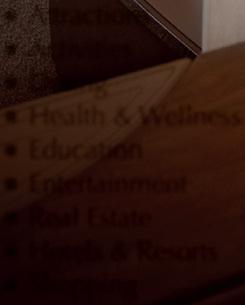


Activities
Dining
Health
Education
Entertainment
Real Estate
Hotels & Resorts
Shopping
The

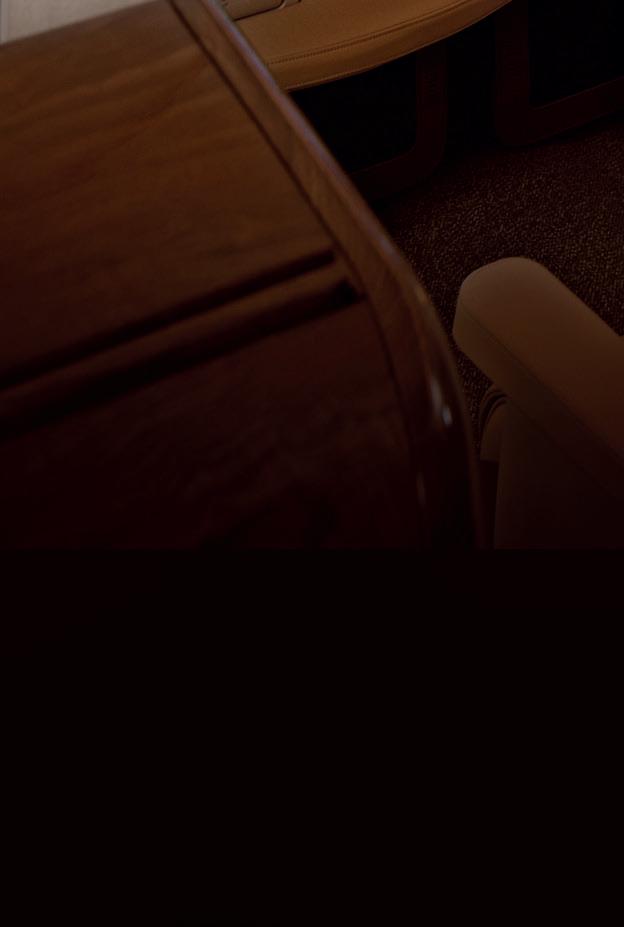













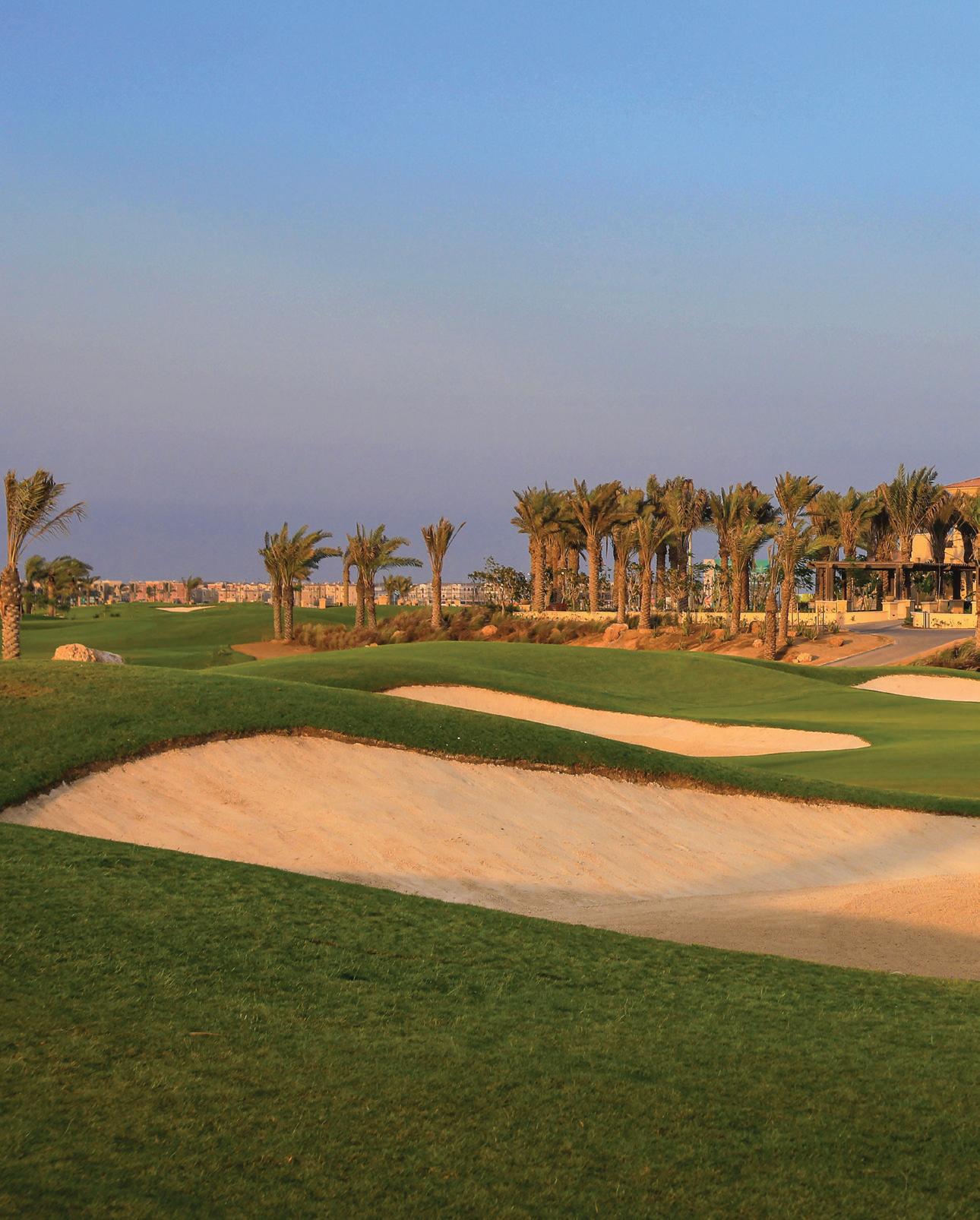
EDITED BY HARRY GRIMSHAW

Royal Greens Golf & Country Club, set along Saudi Arabia’s Red Sea, is a world-class golf destination blending luxury with championship-level play. Having previously hosted top interntaional fields on the DP World Tour, LIV Golf, LET and the Saudi International, it offers stunning views, elite facilities, and a challenging course where the winds keep every round exciting.
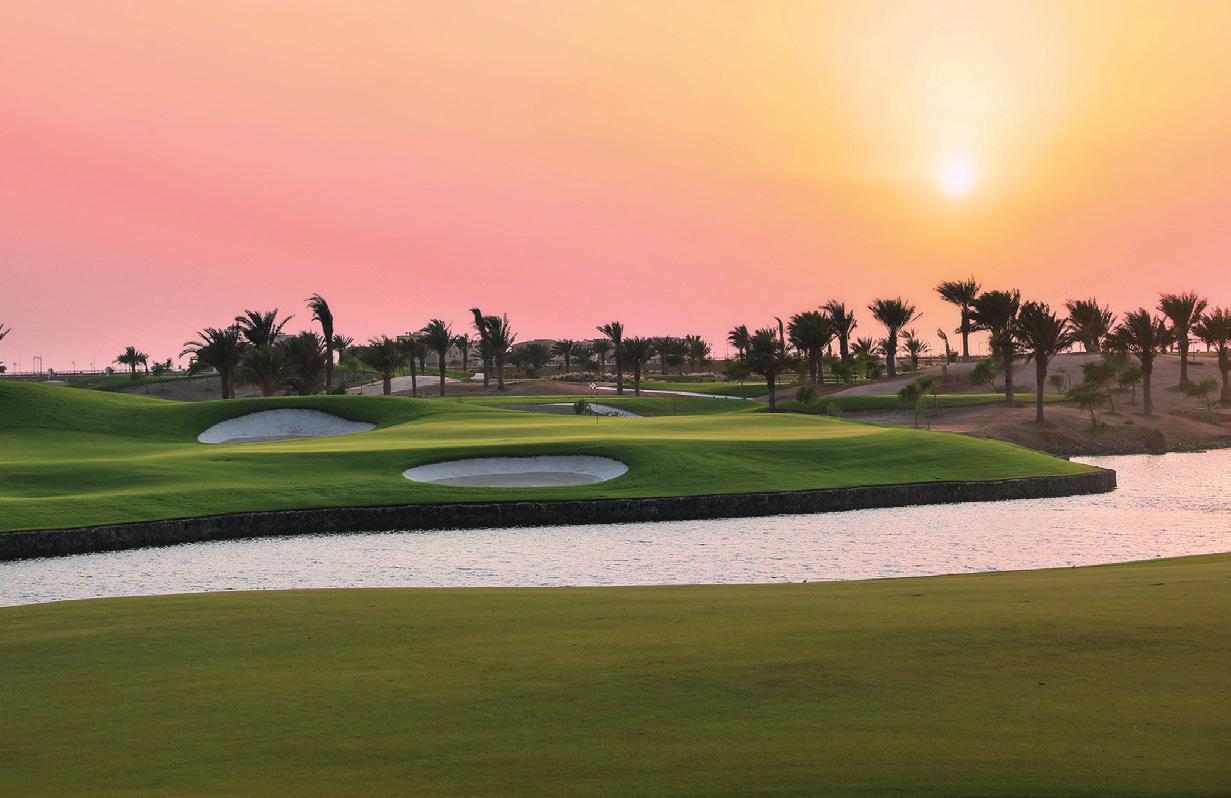
Luxury, prestige, and a course designed for the world’s best—experience golf like never before
NESTLED IN THE HEART of the Al-Murooj district, one of the most prestigious and upscale areas of King Abdullah Economic City, Royal Greens Golf & Country Club boasts a direct view of the Red Sea beaches along the western coast of Saudi Arabia, approximately 100 kilometers north of Jeddah. The district is the largest privately funded new city development in the world and the first dedicated golf community in Saudi Arabia.
This par 72 championship course plays just over 6,900 yards and comprises 18 meticulously designed holes, a luxurious clubhouse and panoramic views of the Red Sea coastline as its natural backdrop. Royal Greens hosted the PIF Saudi International in 2019 through 2023 and the PIF Saudi Ladies International from 2020 until the same year – the first professional men’s and women’s golf events ever played in Saudi Arabia. The club also played host to LIV Golf’s Jeddah events between 2022 to 2024, and the Ladies European Tour’s Aramco Team Series in 2021 and 2022, solidifying its status as a standout venue for international golf events.
Saudi Arabia is currently undergoing a significant transformation in the world of golf, driven by the initiatives of Golf Saudi. Supported by the creation of new courses, with a goal of 30 to be developed by 2030, designed by renowned architects, establishing golf academies and initiatives to nurture local talent, and hosting elite tournaments and events, Golf Saudi is on track to growing the game of golf across the Kingdom.
Royal Greens Golf & Country Club, one of the best golf clubs in the Middle East, aims to create a unique destina-
tion for golfers, from amateurs through to the world’s best, while also attracting those seeking an exclusive lifestyle experience. This vision aligns perfectly with the luxurious lifestyle offered by King Abdullah Economic City. The club provides an ideal opportunity to connect business professionals with the perks that golf offers, creating a golfing experience in Saudi Arabia unmatched by any other club in the region.
Designed by highly skilled professionals, including by Dave Sampson of European Golf Design, Royal Greens

offers a Jekyll and Hyde front and back nine. While going out offers a relatively steady challenge across some great golf holes, the way in is where the stiff Red Sea winds – especially later in the day – come into play, and where the course really comes alive.
It is an undulating par-72 desert-lined course, famed for its iconic par 3 16th which stands parallel to the Caribbeanblue waters of the Red Sea – and where the sea breeze can cause its most chaos. The course is meticulously maintained with wall to wall Paspalum Dynasty heat-tolerant grass, providing an optimal playing surface and preventing discoloration during changeable weather conditions, with Golf Saudi ambassador Dustin Johnson currently holding the course-record of 61, 11 under par.
The clubhouse, developed by architects KTGY and detailed by local Saudi architect HAK, features luxurious interiors designed by HBA, bringing a new level of elegance to the city and its surroundings.
Royal Greens offers a unique experience for all members, whether they choose to enjoy the golf course or simply appreciate the exclusive natural surroundings of the club. It provides a VIP membership that includes private dining, meeting spaces, a world-class cigar lounge offering a walk-in humidor and both an indoor and outdoor environment, billiards room, an executive business center, and other luxury facilities. Additionally, the club features training facilities, a golf academy, a prestigious club with VIP membership, a health club, a spa, and fine dining, making it the finest place for sports and recreation in the region.

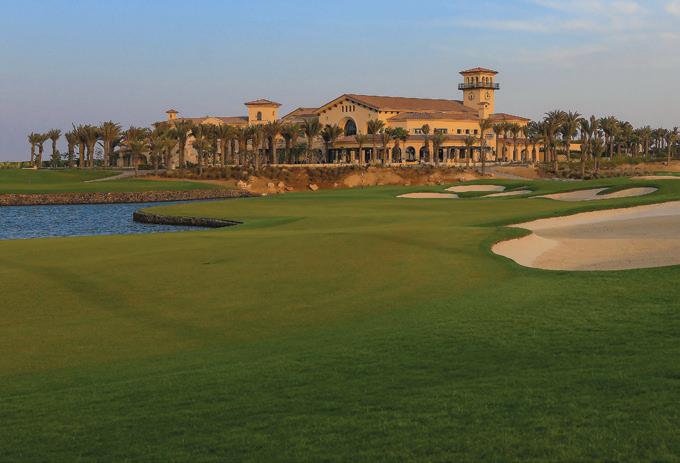
Known as the longest and toughest on the course with a very narrow green, this demanding 470-yard par4 features a dogleg left to the target, requiring both precision and power from golfers to navigate its challenging layout.
Ranked as stroke index 1, this 459yard par-4 is the hardest hole on the course. It tests golfers of all levels with its considerable length and strategic design, presenting a unique challenge after a stretch of birdie opportunities.
This breathtaking par-3 is situated directly on the Red Sea, playing between 120 and 180 yards. The massive green, nearly 15,000 square feet, is narrow and flanked by bunkers, with wind conditions adding to the difficulty of this picturesque hole. The last par-3 on the Kingdom’s most recognisable course is not only visually stunning but also deceptively challenging. During the inaugural Saudi International in 2019, Dustin Johnson nearly lost his lead here before pro-
ducing a miraculous recovery shot from the drop zone to secure a bogey and hold off Li Haotong. Golfers should take par and run, appreciating the turquoise, Red Sea views while respecting the hole’s inherent difficulty.
This 569-yard par 5 is the quintessential risk-reward challenge, enticing players with the tempting option of a long iron shot over water into an undulating two-tiered closing green. The hole has witnessed numerous tournament-defining moments across both the Saudi Men’s International and Saudi Ladies International, with birdies and eagles often paying dividends for those at the top of the leaderboard, and bogeys and higher not uncommon. Playing directly down to the clubhouse, the 18th at Royal Greens presents a beautiful visual reward upon completion of a challenging back nine.
Royal Greens takes great pride in being a host venue for prestigious tournaments, attracting top talent and offering a true test of golf. The club’s commitment to excellence and luxury ensures that every visit is an unforgettable experience, whether you’re there to play, relax, or network.

It’s amazing how much the speed of the greens can change a golfer’s perception of a course. Golfers can play a rather boring course architecturally speaking, but if the greens are rolling fast and true, that might be all they talk about. That presents a challenge to our golf course superintendents, as there are factors beyond their control when it comes to the speed of greens. Don’t even get us started on how Augusta-like greens would affect pace of play.
To understand why green speeds fluctuate and why superintendents can’t simply mow the greens as short as possible to achieve lightning-fast speeds, like at top-tier clubs like Augusta National, we caught up with Jason Meersman, the Director of Grounds at The Patterson Club in Fairfield, Connecticut.
Golf Digest: Jason, why does it seem like the greens at my course are
really fast one day and then much slower the next?
Meersman: The speed of greens depends on a number of factors, including the height of cut, smoothness, slope percentage and fertility inputs. A lot of it is associated with humidity. When it gets really humid, for example, it is much harder to obtain fast greens. The greens won’t roll as quickly as they would under drier conditions. That’s why it’s very challenging to keep your speeds up during the summer.
If your club is used to a 12 on the Stimpmeter in the spring and fall, in the summer months when it gets really humid, it’s tough to maintain that. There’s a little atmospheric layer just above the ground where the humidity is evaporating the water that’s in the ground, and it comes up and creates a little layer. Your ball drags through that, which affects
green speeds anywhere from a foot to a foot-and-a-half.
CUT IT CLOSE
Achieving fast green speeds isn’t as simple as you would think.
That evaporating moisture from the ground just sits on top of the green’s surface, and you can put your hand down there and feel it. It’s warmer down there. Imagine the ball dragging through that humidity. It’s just like when you’re out going for a jog on a humid day, it feels a heck of a lot harder when it’s hot and humid than it does when it’s cool and crisp.
On those humid days, can you just cut the greens shorter?
Meersman: Not quite. There’s a onethird rule that if you cut more than a third of the plant at once, it’s harmful to the plant. You’re scalping it. And when your grass is a tenth of an inch or less, it doesn’t take long for it to grow to a harmful height. That’s why I get my staff to maintain the speed of the greens with the frequency of cut.
OK, but can’t you roll the greens to make them faster as well?
Meersman: Yes, but you have to be careful. Rolling is one of the more aggressive practices you can do. It’s actually more aggressive than mowing. The grass starts dying on the edges of the green where the roller is stopping and going. It’s like when you twist a friend’s arm back and forth to create a burn. That’s what’s happening every time the roller is stopping and going.
When I go to golf courses and the edges are all fried out, it’s usually because they are over rolling, or rolling at the wrong time of the day. Bentgrass doesn’t like to be rolled wet. That pinching motion really hurts the grass when it’s wet. That’s why I like to roll the greens when it’s dry out and toward the end of the day.

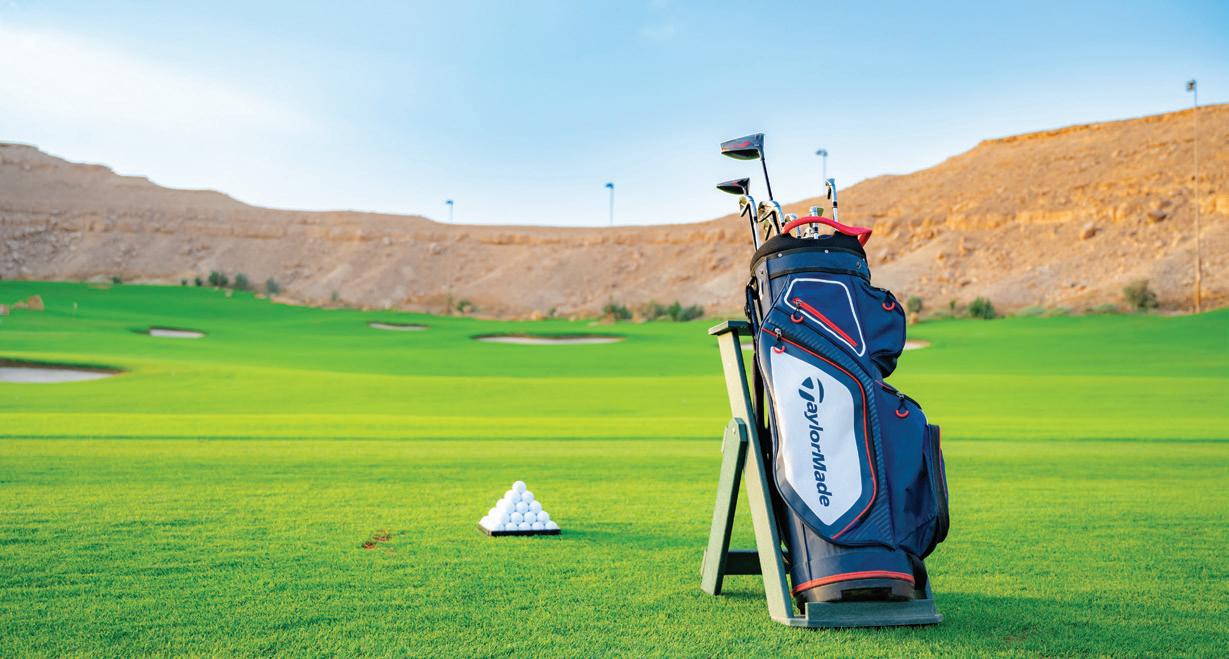
VISION 2030 IN ACTION
WITH DIRIYAH COMPANY
AND GOLF SAUDI

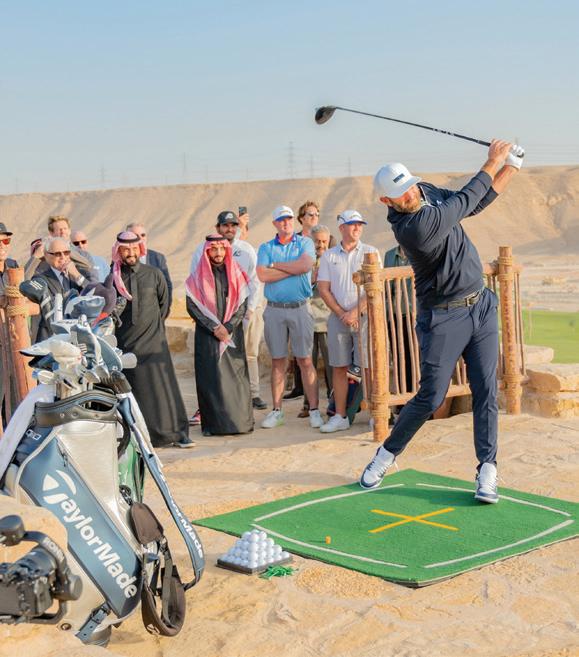
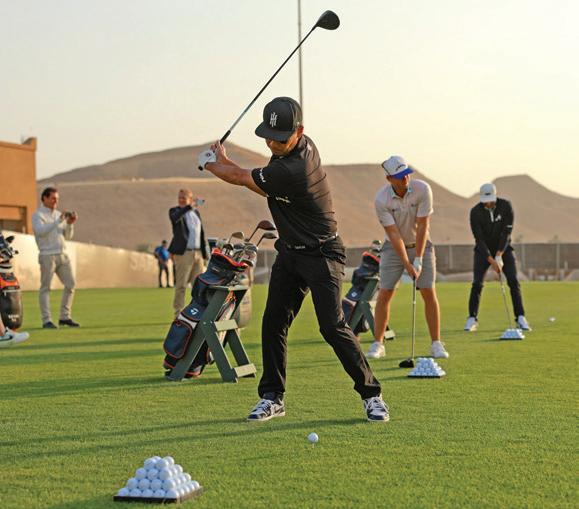
DIRIYAH COMPANY has teamed up with Golf Saudi in a game-changing partnership, making them the official operators of the renowned Wadi Safar Signature Golf Course and the Royal Golf Club just outside Riyadh.
To mark the occasion, a special signing ceremony took place at the Wadi Safar Experience Center and on the course itself. The event brought together key leaders, Golf Saudi ambassadors, pro golfers, and select media, all witnessing a major milestone in Saudi Arabia’s growing golf scene.
This partnership is a big step in the Kingdom’s transformation and aligns perfectly with Vision 2030.
‘THIS IS A HUGE MOMENT FOR DIRIYAH AS A GLOBAL DESTINATION. WE’RE RAISING THE BAR FOR GOLF TOURISM AND SUPPORTING SAUDI ARABIA’S VISION 2030.’
– JERRY INZERILLO
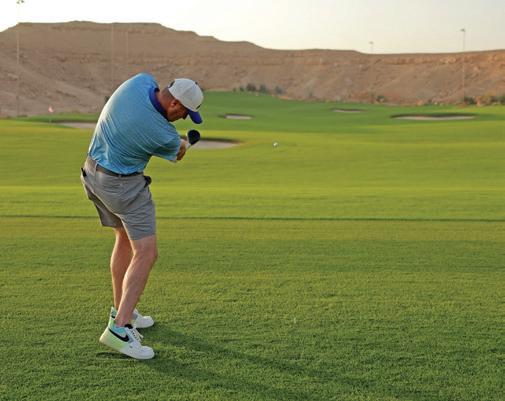
Jerry Inzerillo, Group CEO of Diriyah Company, and Noah Alireza, CEO of Golf Saudi, both spoke about how this collaboration will help shape Diriyah into a world-class cultural and lifestyle destination.
The Wadi Safar Signature Golf Course, now fully finished, is a stunning mix of luxury and sustainability. Designed by golf legend Greg Norman, the course covers 630,000 square meters and includes an 18-hole championship course, a 9-hole academy course, a driving range, and short-game practice facilities—all just a stone’s throw from the UNESCOlisted At-Turaif.
Jerry Inzerillo shared his excitement about the partnership: “This is a huge moment for Diriyah as a global destination. The Wadi Safar Signature Golf Course and Royal Golf Club combine world-class golf with the rich history and natural beauty of Diriyah. Together, we’re raising the bar for golf tourism and supporting Saudi Arabia’s Vision 2030 by creating sustainable, inclusive, and iconic developments.”
Noah Alireza, CEO of Golf Saudi, also expressed his enthusiasm: “We’re thrilled to partner with Diriyah Company on this exciting project. Wadi Safar is set to change the game for golf in Saudi Arabia. Our aim is to set a new standard for golf tourism, putting the Kingdom on the global map while staying true to sustainability and cultural heritage.”
As the official operator, Golf Saudi will bring its expertise to Wadi Safar, ensuring that golfers and visitors enjoy a world-class experience. This partnership not only solidifies Diriyah’s place as a top golfing destination but also plays a key role in Saudi Arabia’s vision of becoming a leader in sports, tourism, and cultural innovation.
Golf in the Arab world is experiencing a milestone transformation, driven by ambitious investments, a surge in grassroots, and the emergence of world-class tournaments. But while the region has attracted some of the sport’s biggest names and a growing fan base, a critical piece of the puzzle has been missing – a clear, structured, tournamentled ranking system to identify, develop, and elevate homegrown talent.
The Arab Golf Federation (AGF) is now filling that gap with the launch of the new Arab Golf Series (AGS) and its official ranking system, and the timing couldn’t be better. This game-changing initiative is designed to unify amateur competition and create a crystal-clear pathway for rising talent all the way to the very top, with the ultimate ambition of delivering a future Arab champion on golf’s global stage.
Founded with the mission to grow the game across the Arab world, the AGF represents the interests and ambitions of 17 national federations. A driving force to elevate the sport, foster the development of amateur and professional players, and increase access to the game for future generations. Beyond competition, the Federation is committed to promoting the sport at the grassroots, increasing participation, and securing the-long term sustainability of golf in the region.
With the Middle East leading a regional golf revolution—hosting elite tournaments, investing in grassroots golf, and championing player development at all levels—the AGS provides the missing link: a system that allows the region’s amateurs to track their progress, earn opportunities, and compete against the biggest and best names in world golf.
For the first time, Arab golfers will have a standardised, points-based system to rank their performances, just like the professional tours and aligned with global standards. The AGS assigns points to rising amateurs based on three key factors:
• Strength of field – High-caliber events will carry more ranking significance
• Number of players – Larger, more competitive field increase point values
• Consistency of performance – Strong results over multiple events equal stronger points More than just a ranking, the system serves as a launchpad. For example, a young golfer from


Riyadh who consistently performances in AGS events can now establish their status, earn invites to elite regional and international tournaments, and open doors to the global stage.
The 39th Qatar Open Amateur Golf Championship, held at Doha Golf Club from February 20-22, 2025, marked the official launch of the AGS ranking system. To those involved, the tournament wasn’t just another amateur event; it was a turning point.
For the first time, a regional tournament implemented the AGS ranking system, awarding points that will shape the AGS’ first official standings. With a strong field of amateur golfers from across the Arab world, the event showcased emerging talent and set a precedent for how the ranking system will influence competitive golf in the region.
Qatar’s own Saleh Al-Kaabi took full advantage of this new era of regional golf, showcasing exceptional skill to top the leaderboard – and secure a strong opening footing on the AGS rankings – with a one-stroke victory in front of a home crowd.
With visions now firmly set on the future, the AGS will expand with a full regional schedule, including tournaments such as the Cedars Golf Championship at Al Zorah Club in Ajman, UAE, the Pan-Arab Ladies & Juniors Championship, and the Jordan Open. The growing calendar will provide more players with ranking opportunities, increasing visibility and competitive depth across the region.
THE
HOME WIN Qatar’s own Saleh Al-Kaabi won the 39th Qatar Open Amateur Golf Championship
Beyond individual tournaments, the real impact of AGS will be seen in how it reshapes golf’s ecosystem in the Arab world. By providing a unified competitive structure, it will make talent identification more seamless, improve the region’s standing in international golf, and inspire the next generation of Arab Golfers to pursue the sport at the highest levels.
The Launch of the Arab Golf Series and its ranking system marks a defining turning point for the sport in the region. With a clear pathway for amateur players, the AGF is ensuring that talent is not just recognised, but actively championed.
For Saudi Arabia, this initiative is particularly significant. With world-class tournaments, a growing base of young talent, and Golf Saudi’s commitment to long-term development, the country is positioned to become one of the most influential forces in global golf.
As the AGS unfolds over the coming seasons, it could very well be the catalyst that produces the first wave of Arab Golfers to truly compete on the world stage. What was once a distant dream is now a structured, achievable reality – and the future of Arab golf has never looked stronger.

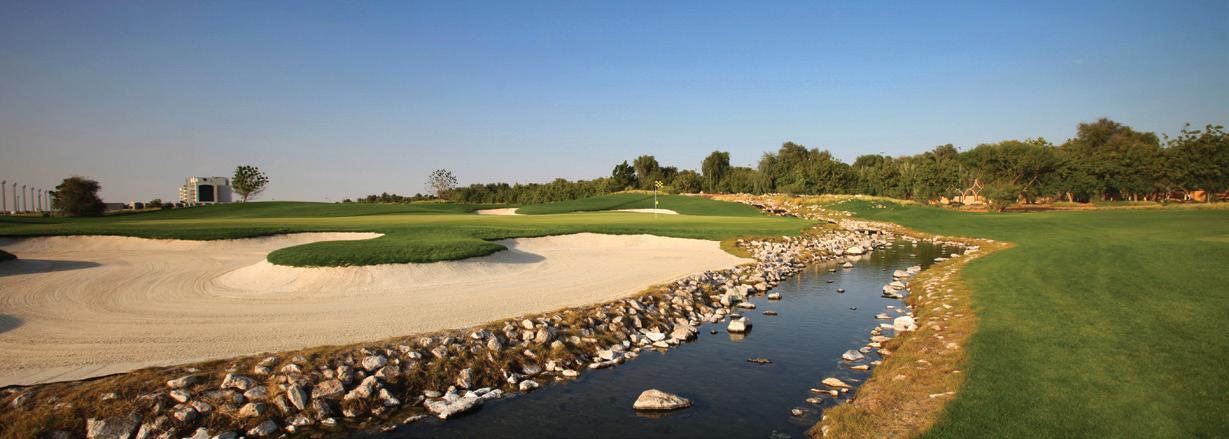
UAE’s golfers set their sights on success via the HotelPlanner
The HotelPlanner Tour, alongside the Emirates Golf Federation (EGF), is gearing up once again across the UAE to showcase the best global professional golfers striving to secure a place on the DP World Tour.
The €9,000,000, 29-tournament-long 2025 Road to Mallorca Rankings season arrives in the Emirates of Ajman and Abu Dhabi in mid-April for back-to-back events, having already traveled to South Africa for its opening four events and, more recently, to India for a doubleheader.
Now, the recently rebranded HotelPlanner Tour has its sights set on the UAE Challenge at Al Zorah Golf and Yacht Club, followed by the Abu Dhabi Challenge at Al Ain Equestrian, Shooting & Golf Club the following week.
This marks the third edition of both events, highlighting the 10-year agreement between the DP World Tour, HotelPlanner Tour, and the EGF to develop the game of golf in the region.
“These two events are a vital part of our strategy to establish a comprehensive development pathway for golf in the UAE,” said EGF Vice President General Abdullah Alhashimi (right). “At the Emirates Golf Federation, we are focused on providing opportunities for players to grow from grassroots to the highest tiers of professional golf, creating a complete ecosystem for player development.

“These HotelPlanner Tour events play a crucial role in that system, offering competitive platforms for our local talents to progress. Our vision is to position the UAE as the leading destination for golf in the region, and events like these are central to achieving that goal.”
Alongside UAE professional Joshua GrenvilleWood, three talented UAE amateurs—Sam Mullane, Ahmad Skaik, and Jonathan Selvaraj—will also


be competing, fresh off their recordsetting success at the GCC Golf Championship in Saudi Arabia.
“We’re incredibly proud to see these three amateurs earning their places in the field,” added General Alhashimi. “It reflects their hard work and the steady rise in their performance levels. Their participation is significant, not only because they are representing the UAE on an international stage, but also because it sends a powerful message to the next generation of Emirati golfers.
“These players are now competing against elite professionals, testing themselves at a higher level, which is essential for their growth. This is precisely why we invest in hosting these kinds of events—so our players can challenge themselves, gain experience, and measure their progress. Their continued development is a promising sign for the future of golf in the UAE.
“Additionally, we are pleased to have participation from other Arab countries. This is not only a testament to the growing strength of golf in the region but also an important step in fostering regional collaboration.
“It aligns with the broader objectives of the Arab Golf Federation—to raise the standard of play, increase opportunities for Arab golfers, and collectively promote the sport. These tournaments serve as a platform to unite players from across the Arab world, helping to drive the game forward on a regional scale.”
UAE national Ahmad Skaik led his team to capture their fi rst-ever Team Golf Medal at the 2025 GCC Championship at Royal Greens Golf & Country Club. At the same time, he delivered a record-breaking performance in the Individual Division, fi nishing 18 under par—15 shots ahead of his nearest competitor—to take home the Gold Medal.
“I’m really looking forward to playing the HotelPlanner Tour with all the guys,” said Skaik. “My confidence is high, especially after winning the GCC Championship in Saudi. I broke many of my own records—fi rst time
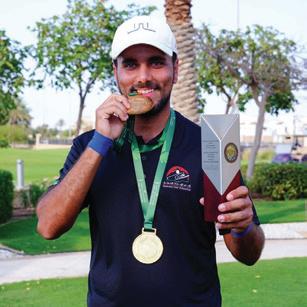
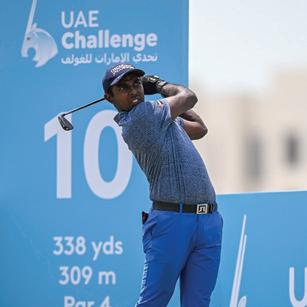
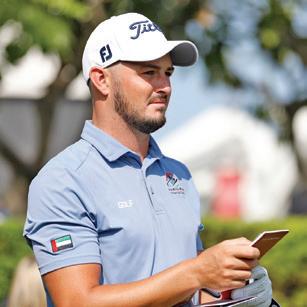
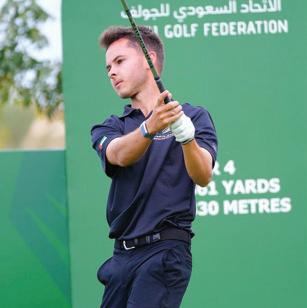
“I don’t want to just play to gain experience—I feel like I can actually compete now”
–AHMAD SKAIK
shooting four rounds under par, all in the 60s. My best tournament score was six under, and now it’s 18 under! So, there are plenty of positives to take from that recent win.
“It’s always great to play big events, especially at home with all the support we get and on familiar courses. It’s going to be amazing to tee it up alongside the other UAE Nationals, and it will be a fantastic experience for all of us.
“But most importantly, if I feel on top of my game, stay healthy, keep practicing, and remain sharp, I know I can compete. I don’t want to just play to gain experience—I feel like I can actually compete now.”
Ahmad’s fellow UAE National player, Sam Mullane, is relishing the opportunity to compete on one of golf’s global tours following his success in the GCC Championship and additional silverware in regional events.
“I’ve been playing pretty well recently, and I’m trying to carry some momentum from the amateur tournaments as I prepare to play on home soil. Playing alongside Ahmad and Jonathan will be awesome—we always enjoy playing and travelling together as a team, so hopefully, we can all put in a good performance and see how it goes.
“I’m just focusing on playing the way I do in amateur tournaments when stepping into professional events and not letting the scale of the occasion affect me. I think that’s something that has let me down in the past, but I’ve learned from my mistakes now. I haven’t always performed the way I know I can, but I hope my recent wins will help me deliver on the bigger stage.”
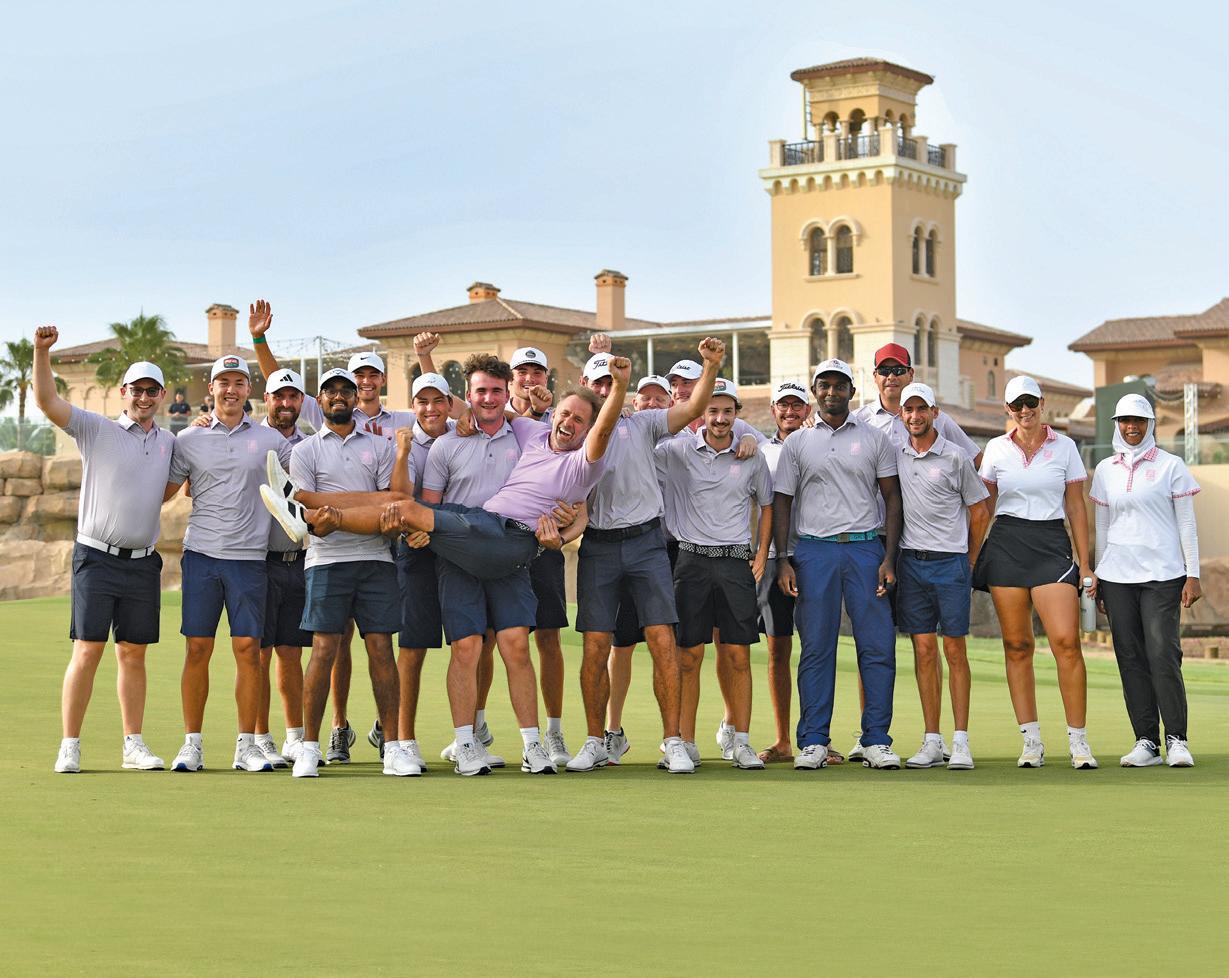
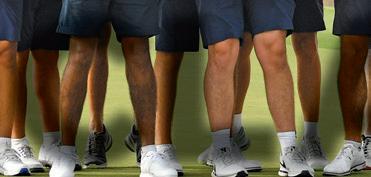
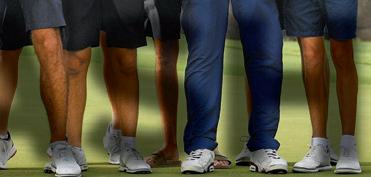
N JUST A FEW WEEKS, one of the UAE’s longest-standing golf tournaments returns for its 26th edition.
The Dubai Golf Trophy will once again see the country’s top male and female Professionals take on the best male and female Amateurs in a Ryder Cup-style showdown over two competitive days.
But you can’t just walk onto the team. To earn a spot, the top 12 Professionals qualify through the Emirates PGA’s Dubai Golf Trophy Order of Merit, based on their best six fi nishes across the season. The Amateurs follow a similar process, with the top 12 coming from the EGF’s Gross Order of Merit.
The remaining four spots on each team are Captain’s Picks—selected at the discretion of Professional Captain Graham Forbes and Amateur Captain Dan Byrne. However, there’s a catch: Pros must have played at least five Emirates PGA events, while Amateurs need a minimum of five UAE Open appearances.
The event also features a Ladies Challenge Match, with the top two Professional Ladies facing off against the top two Amateur Ladies, based on their respective Order of Merit standings.
Originally established by Dubai Golf, the event rotates across five world-class courses: Emirates Golf Club’s Faldo and Majlis courses, Jumeirah Golf Estates’ Earth and Fire courses, and the Championship Course at Dubai Creek Golf & Yacht Club. This year see’s day one at Dubai Creek Golf & Yacht Club, with the fi nal day being held on the Majlis Course at Emirates Golf Club.
Despite the Pros’ best efforts, the Amateurs have dominated in recent years, winning nine of the last ten editions. Last year, the Professionals came agonisingly close, but Emirates Golf Club’s Viktor Kofod-Olsen secured a crucial draw on the fi nal hole against Matt Rice from
The standard is getting stronger every year. We’ve got some top-class players in the region now.
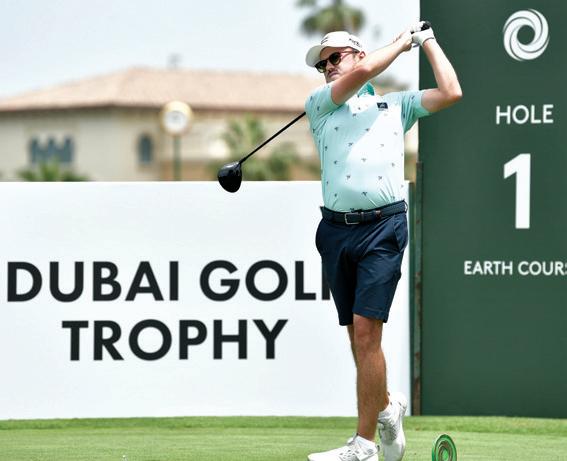
Golf Kraft, resulting in a 16-16 tie and ensuring the Amateurs retained the trophy.
For Professional Captain Graham Forbes, this event is more than just another tournament—it’s personal. Having been part of the Emirates PGA since moving to the UAE four and a half years ago, he knows the significance of this event.
11th May 2025
Dubai Creek Golf & Yacht Club (Foresomes & Fourballs)
12th May 2025
Emirates Golf Club Majlis Course (Singles)
“This event is special—it always has been. It brings the best players in the region together, and that creates a real buzz,” Forbes explains. “But as a captain, it’s different. There’s pressure, but it’s a privilege. You’re not just playing for yourself; you’re leading a team, making decisions, and trying to inspire the guys around you.”
His own record in the Dubai Golf Trophy speaks for itself—10 points from a possible 12 in previous appearances. But after last year’s heartbreak, he’s determined to do whatever it takes to bring the trophy back to the Professionals.
“We thought we had it last year. It came down to the final hole, and we were right there. To see it slip away was tough,” he admits. “That feeling stayed with us. The Amateurs have dominated this event, and as much as we respect what they’ve done, it’s time to change the story.”
“The standard is getting stronger every year. We’ve got some top-class players in the region now, and I think that’s going to show in this year’s event.”
While he wants to bring the trophy back to the Professionals, Forbes also sees this event as something bigger. “The Dubai Golf Trophy is about more than just winning—it’s about the bond between the players, the friendships, and the respect we have for each other. The competitive fire is there, but so is the camaraderie. That’s what makes it special.”
On the Amateur side, Captain Dan Byrne shares a similar sentiment. This will be his sixth consecutive appearance in the Dubai Golf Trophy, an event that became a personal goal to qualify for when he first moved to the UAE. “It’s the perfect way to close out the season,” he says.
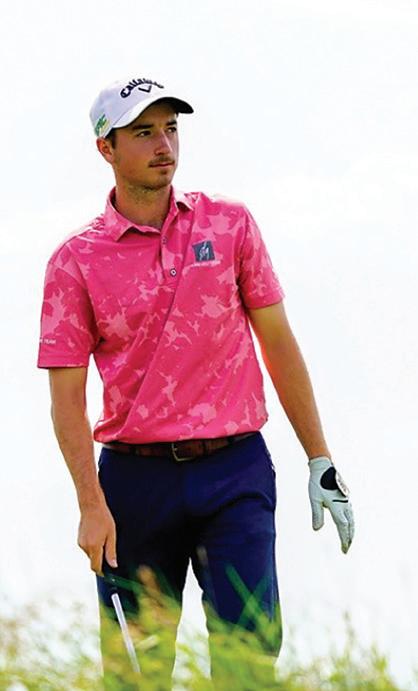
“We spend all year competing against each other, grinding it out in individual events, and then suddenly we’re all on the same side. That shift in mentality, from rivals to teammates, is what makes this event so exciting.”
The Amateurs have had the upper hand in recent years, but Byrne isn’t letting that cloud his focus. “We were very fortunate to retain the trophy last year. Some of the matches came down to the wire, and we pulled off a few miracles in the final stretch. We know we can’t rely on luck this time.
“The Professionals are stronger. We’ve lost a few key players, and I’ve heard they’ve got some new additions that will make a difference. I’d say we’re the underdogs this time, and that’s a position we haven’t been in for a while.”
Despite that, Byrne is relishing the opportunity to lead. “It’s an honour to be captain. I know what this event means to everyone involved, and I want to make sure we approach it the right way. We’re here to compete, to give everything we have, but also to enjoy the experience. That balance is key.
“Some of the guys playing this year will be experiencing the Dubai Golf Trophy for the first time, and I want to make sure they embrace it. It’s a pressure-packed event, but it’s also one of the most enjoyable tournaments you can be part of.”

The Emirates PGA has come a long way since its formation in 1995, evolving into a thriving hub for golf professionals in the UAE. Now it’s packed with a tournament schedule, a highly competitive Order of Merit, and exciting opportunities for its members, the organisation is playing a vital role in raising the standard of professional golf in the region.
At the heart of the Emirates PGA is it’s Order of Merit, a season-long ranking that bases the players on their performances throughout the season. For professionals like the Tommy Fleetwood Academy Dubai’s Jackson Bell, the current Order of Merit leader, this ranking is more than just a number—it’s a stepping stone to greater opportunities in the game.
Bell, who has been competing in the Emirates PGA since moving to the region six and a half years ago, thrives on the challenge that tournament golf presents. “I just love competing— in anything, to be honest, but especially golf,” he says. “Golf is fun socially, but it’s tournament golf that really gets the juices flowing for me.”
Despite undergoing three hand surgeries and being sidelined for over a year, he now finds himself at the top of the rankings. “To be sitting at No. 1 after not playing golf for over 12 months is a big surprise, so I’m really happy with it,” he admits. “My putting has been really poor this season, but from tee to green, I’ve been excellent. There’s still room for improvement, which is nice, I guess!”
The Emirates PGA has significantly expanded its tournament offerings over the years. What once consisted of just a handful of events now boasts a full calendar of nearly 30 tournaments spanning the length and breadth of the UAE, giving professionals like Bell regular chances to hone their skills in a competitive environ-
ment. “Having events nearly every week is great as it motivates us to put in extra time to practise and play,” Bell says. “The courses we get to play in the UAE week in and week out are worldclass, which is another great reason to get out and play.”
The increased schedule isn’t just about keeping its members active—it also opens doors to higher levels of competition. Players who perform well in the Order of Merit can earn spots in prestigious events like the Clutch Pro Tour and the HotelPlanner Tour, providing a direct pathway to compete against some of the best in the world.
For Kieren Pratt, Managing Director of the Emirates PGA, the organisation’s mission extends beyond just hosting tournaments. “It’s all about getting together and continuing to compete at a high level while still working in the golf industry.”
Around 50% of its members are teaching professionals, while the rest work in operations and golf management. The association’s events not only provide playing opportunities but also serve as a platform for members to connect, share experiences, and support each other’s careers.
The remainder of the season promises to be an exciting one, with key tournaments still to come. The highlight is the Emirates PGA Championship at Al Zorah Golf Club in Ajman on April 21st and 22nd, a crucial event that will determine the final Order of Merit standings.
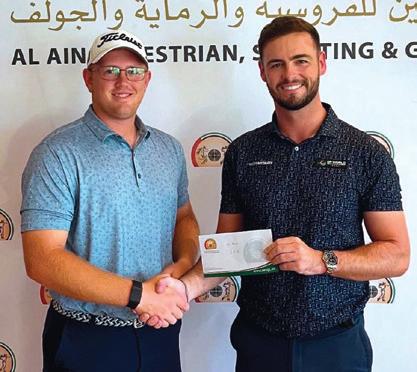
Beyond the tournaments, the Emirates PGA is looking to expand its offerings for its members. Discussions are underway for a partnership with Cobra Puma Golf, which would introduce a personal development programme for professionals. “This will make it more attractive for both career and personal development,” continued Pratt. “While nothing has been finalised yet, it is looking very likely.”
The future looks brighter than ever for the Emirates PGA and its members.



























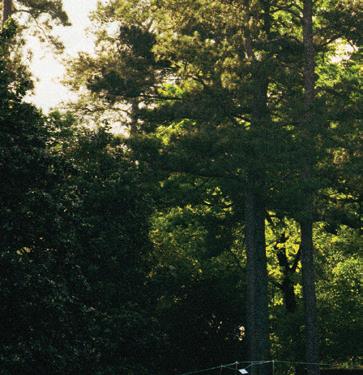




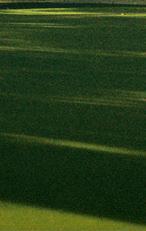

The creation stories of Augusta National’s bunkers
BY DEREK DUNCAN
OF ALL THE GOLF COURSES most known for their beauty, Augusta National is the most ephemeral. Merely to evoke the name is to conjure images of flawless green bursting through hues of bright pinks, reds, yellows, greens and whites, each fairway escorted by courtly arrangements of towering southern bloom.
It’s tempting to think this is the natural state of Augusta National, but the playing of the Masters—the only time 99.9 percent of us see the course—is timed to coincide with the seasonal outburst of its immense flora. The orchestration is overwhelming, but it comes and goes quickly, an early April Brigadoon that soon disappears from everything but the mind’s eye.


No other great course’s aesthetics are so fleetingly attached to reality as Augusta’s.
If you play the course in November or February or late April as most members and guests do, its beauty is more monochromatic, the technicolor dreams dialed down to ordinary emerald hues. Or if you were to see it in the summer when the club is closed, brown.
One aesthetic that doesn’t phase in and out is Augusta National’s bunkers. Though it possesses fewer than most nationally ranked courses, just 44, their presence is immense. They are the statues in the garden, their placement carefully considered and shapes exquisitely honed. The bright white, scalpel-edged bunkers are as much
a part of our vision of the ideal Augusta National as the closely cropped turf, glassy blue ponds, skyscraper pines and kaleidoscope scenery.
The pearl upsweep of Augusta National’s bunkers was decades in the making.
While the founders always intended to show off the property’s wide range of trees, shrubs and flowering plants— Augusta National was previously a nursery and chairman Clifford Roberts eagerly embraced the existing botanicals as part of the club’s identity—the bunkers were not originally meant to be so perfect. Their journey toward statuesque status has been a long one.


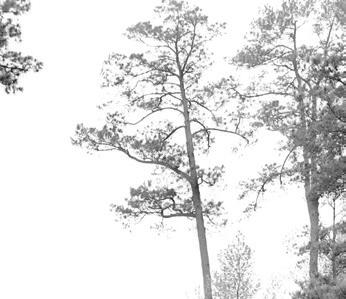
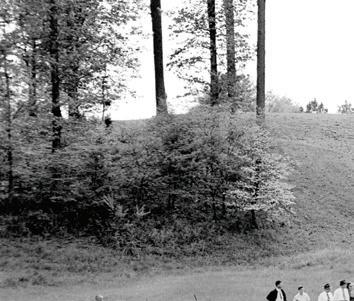
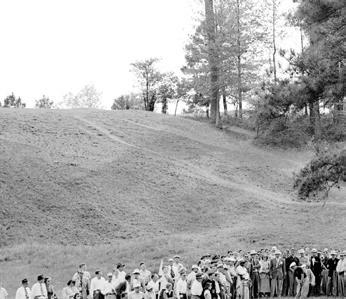
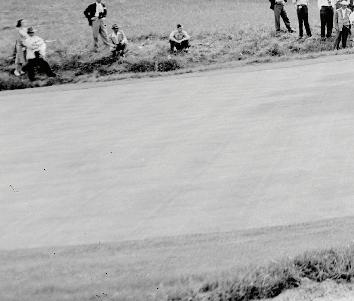

Augusta’s original architect, Alister MacKenzie, believed that good design should strive to be indistinguishable from nature, and he intended for his courses to blend into their surroundings. This was easier done in the sand and dunes of links designs—or the dunes of Cypress Point, or the sandbelt of Melbourne. The hard clay soils of Georgia, however, did not lend to the kind of eroded-edge bunker style that might seem indigenous in nature. Nevertheless, MacKenzie attempted to make his bunkers at Augusta National appear haphazard and not artificial, and he had them built with irregular lobes, tongues, capes and scribbled edges. They were also relatively shallow and flush to the grades beneath them since deeper bunkers in the poor-drain-
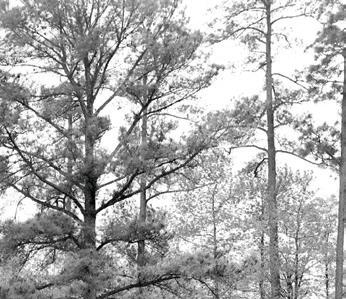
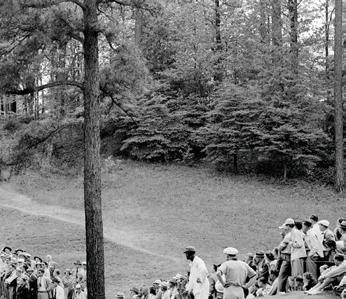



ing clay soils would quickly fill up with water during storms.
MacKenzie’s filigreed edging at Augusta National faded through the lean Depression years of the 1930s due to the economics of maintenance, course alterations and lack of his oversight (he died in 1934). Perry Maxwell, MacKen-
While the founders always intended to show off the property’s wide range of trees, shrubs and flowering plants, the bunkers were not originally meant to be so perfect.
UNINTENDED
The rugged bunker edge at the new 16th hole in 1949 would make many contemporary designers smile.
zie’s former partner who began making architectural changes in 1937 by building new greens and bunkers, was known for a naturalistic style of his own in original designs, but the new hazards he built at holes like seven, nine and 10 didn’t have the same ornate shapes and edging of MacKenzie’s. Augusta National closed temporarily during World War II, and the Masters was suspended from 1943 through 1945. During this time the holes went fallow (the property was used to graze livestock as a revenue source), and when it reopened, considerable work was needed to repair the course. The details of whatever remained of MacKenzie’s bunker concepts were largely erased.
As the club resumed normal operations after the war, it hired Robert Trent Jones to modernise the course. Jones was known for building rugged, cloverleaf-shaped bunkers, but those he constructed or renovated at holes like No. 1, 16 and 18 bore a more open-faced, utilitarian look common in the post-war era for their relative ease of maintenance.
Architect George Cobb became the club’s consulting architect in the 1950s and continued the pattern of enlarging, simplifying and shifting bunkers. Those behind the 13th green, for instance, became rounded and moved higher up the back hillside. He also filled in MacKenzie’s large, intricately shaped fairway bunker on the 14th hole and shifted another centerline crosshazard on the par-5 eighth to the right side of the fairway. Later, in the 1960s, Cobb relocated the central bunker on the par-5 second hole to a position further down the fairway toward the outside corner of the dogleg.
During this era the bunker shapes settled into the formats we recognise today, though they retained a rougharound-the-edges appearance due to the use of riding mowers that stopped short of clipping the bunker perimeters. They were still, however, quite shallow due to drainage concerns and the type of coarse sand in use. By the late 1960s, mechanical hand-edgers became popular throughout the industry, and Augusta National was able to create defined lips around the bunkers. The side effect of using spinning metal blades to edge the bunkers was that slivers of earth were sometimes scalped away with each pass, and slowly the size of the bunkers grew as the lips incrementally widened.
One of the most impactful changes to the bunkers occurred before the 1975 Masters. For decades the sand had been off-white with coarse, rounded particles (probably locally sourced), and players frequently had to play explosion shots when balls cratered. Roberts noticed the sand at his home club in western
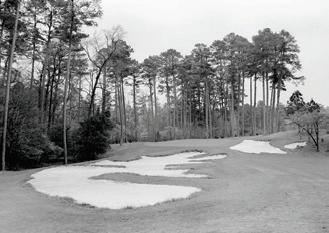
LOW-RES
The bunkers were maintained like most other golf courses during the ‘50s and ‘60s.
North Carolina was different and discovered they were sourcing it from a nearby quarry. Roberts had the new, pearl-white sand trucked into Augusta National and installed in its bunkers prior to the 1975 tournament.
Called North Carolina Spruce Pine sand, it was made of quartz (igneous rather than from sedimentary rock) and had a finer, more angular structure. Not only was it a firmer and more consistent surface to play from (meaning better shot control), but the shape of the particles made it able to stand up vertically against the faces of the bunkers that had been getting gradually steeper and more upswept. Though significant
work was required to push the sand back up the slopes when rain washed it out, the high, white oval faces nudging into the greens became entrenched as a defining aesthetic.
DRAINAGE, DRAINAGE
Notice the standing water in the bunker on the 16th, even in the 1960s.
When Augusta National hired Billy Fuller to be the superintendent following the 1981 Masters, the club was not the turf and conditioning superpower it has become. The maintenance facilities and commitment to agronomic science was not much different than other clubs, but the ’80s marked a renaissance period of turf and conditioning, starting with Augusta National’s conversion of its greens from Bermuda grass overseeded with rye to firmer, faster bentgrass. After a misstart in 1981 Fuller was hired for the 1982 Masters, and several years later installed the first prototype hydronics system that could help control soil temperatures under the troublesome 12th green. Drainage continued to be the bane of the bunkers, and each summer the sand had to be cored out and the drainage repaired. To avoid
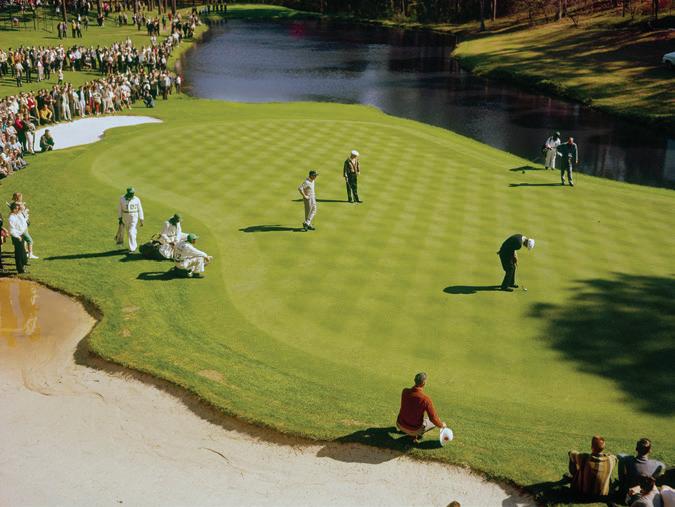
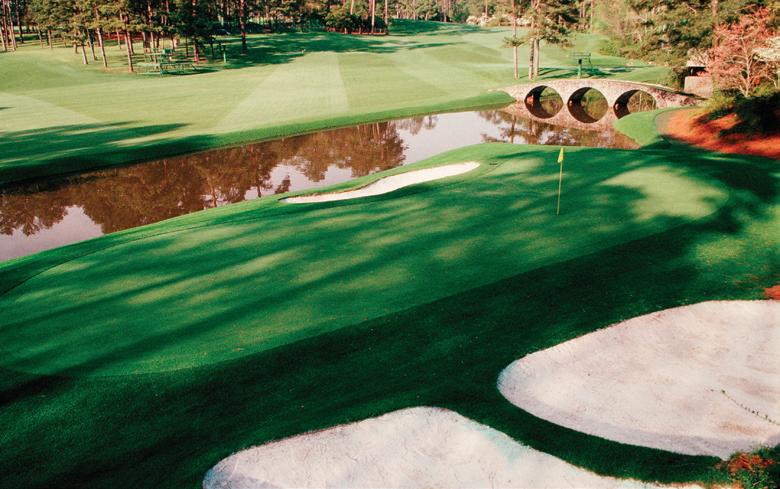
this costly expenditure, Fuller developed the first type of bunker-liner system. During the summer of 1982, he and his crew rebuilt every bunker on the course, lining each with two inches of gravel and covering that with a polymer membrane before replacing the sand. The system allowed water to pass through the sand and liner, then drain down behind the sand through the gravel. After rainstorms, 90 percent of the sand continued to adhere to the bunker face, eliminating the need to shovel it back up the slope or do annual repairs. Today, bunker-liner systems such as this, which later came to be called the Better Billy Bunkers, are standard throughout the industry.
The last new bunkers at Augusta National were also added during this time, in 1983, when consulting architect Jack Nicklaus suggested the fairway bunker left of the third fairway would be a more effective hazard if it were broken into a series of bunkers (there was even talk of adding a small pond in that location). The single existing bunker became four, and the number and style of the bunkers has not meaningfully changed since then.
The most notable work done at Augusta National during the mid-1990s
HI-RES
By the late 1980s, the bunkers had the manicured, precise look that we now associate with all aspects of Augusta National.
was the continuing installation of more sub-surface heating and drainage systems under the greens, and the addition of the second cut of rough in 1999. The club made Tom Fazio its consulting architect, though aside from the continuing improvements in course-wide drainage and subtle alterations around the greens, no major architectural projects were undertaken until 2002. These included the “Tiger-proofing” of select holes through lengthening, and the subsequent addition of new pines on holes like 11, 15 and 17. The club has continued to lengthen holes where it can and occasionally institutes more substantial changes like the remodel of the 11th hole for the 2022 Masters.
During this time, the appearance, number and placement of Augusta National’s bunkers has been relatively consistent, the detailing of their shape and edging now dialed in. The last significant changes have been the shifting of several fairway bunkers: on the first and eighth holes in 2002, when both were moved 15 yards further down the fairway; at 18 where the two left-
Augusta National course superintendent Billy Fuller developed the first type of bunkerliner system. During the summer of 1982, he and his crew rebuilt every bunker on the course.
side bunkers were expanded during the 2011 lengthening; and at the par-4 fifth where the two inside left bunkers were made smaller, deeper and pulled slightly closer to the tee after the hole was lengthen by 40 yards.
It’s in these bunkers where Fazio’s group has slowly brought its own aesthetic to bear. Both the first and eighth fairway bunkers have been deepened and reshaped with a more curveand-cape top line, not as ornate as MacKenzie’s bunker on 10 but with more unique character than most of the other bunkers at Augusta National.
The bunkers have come a long way from the scrapes and scabs that MacKenzie’s crews dug into the Georgia clay, but it’s important to note there was no unifying force guiding their changing forms. Through piecemeal remodeling by different architects, the passage of time and improvements in drainage, sand texture and other maintenance advances, they’ve evolved into an array of yawning shapes that take the form of oyster shells, bowls, deep amoebas and a few that make a faint nod to MacKenzie, though he might argue that notion.
It would be sacrilegious to alter this aesthetic now, one that’s been entrenched for over 50 years, far longer than the look that existed when the course debuted in 1933. While the course blooms and recedes around them, the 44 white sculptural forms efficiently control the playing strategies and define how we think of Augusta National as much as any other element of the design. The bunkers might continue to shift and expand as needed, but their presence and presentation has, at last, moved from evolving to immutable.
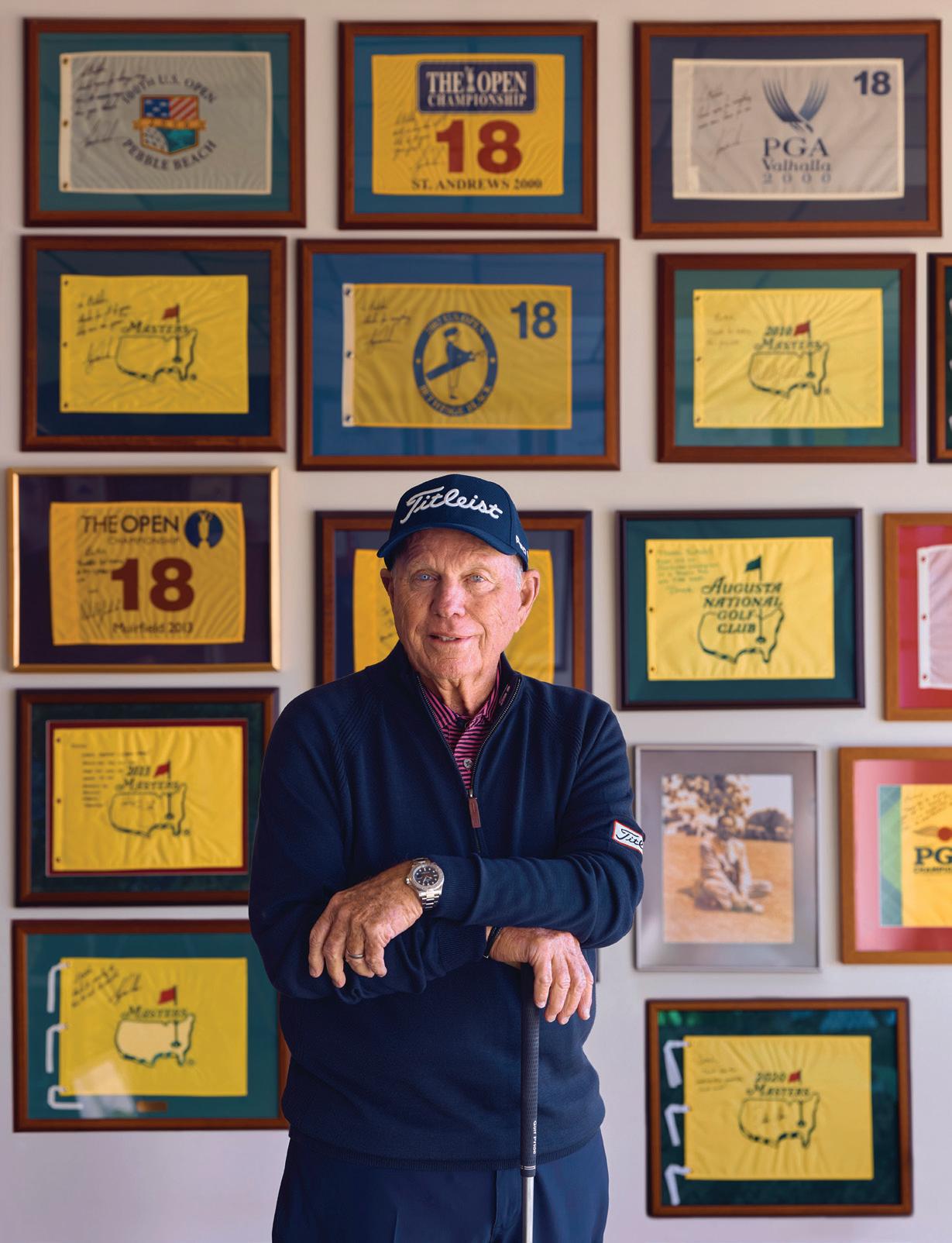
THE REAL STORIES OF SIX UNFORGETTABLE MASTERS SUNDAYS FROM INSIDE THE ROPES BY BUTCH HARMON WITH PETER MORRICE
PHOTOGRAPH BY STEPHEN DENTON
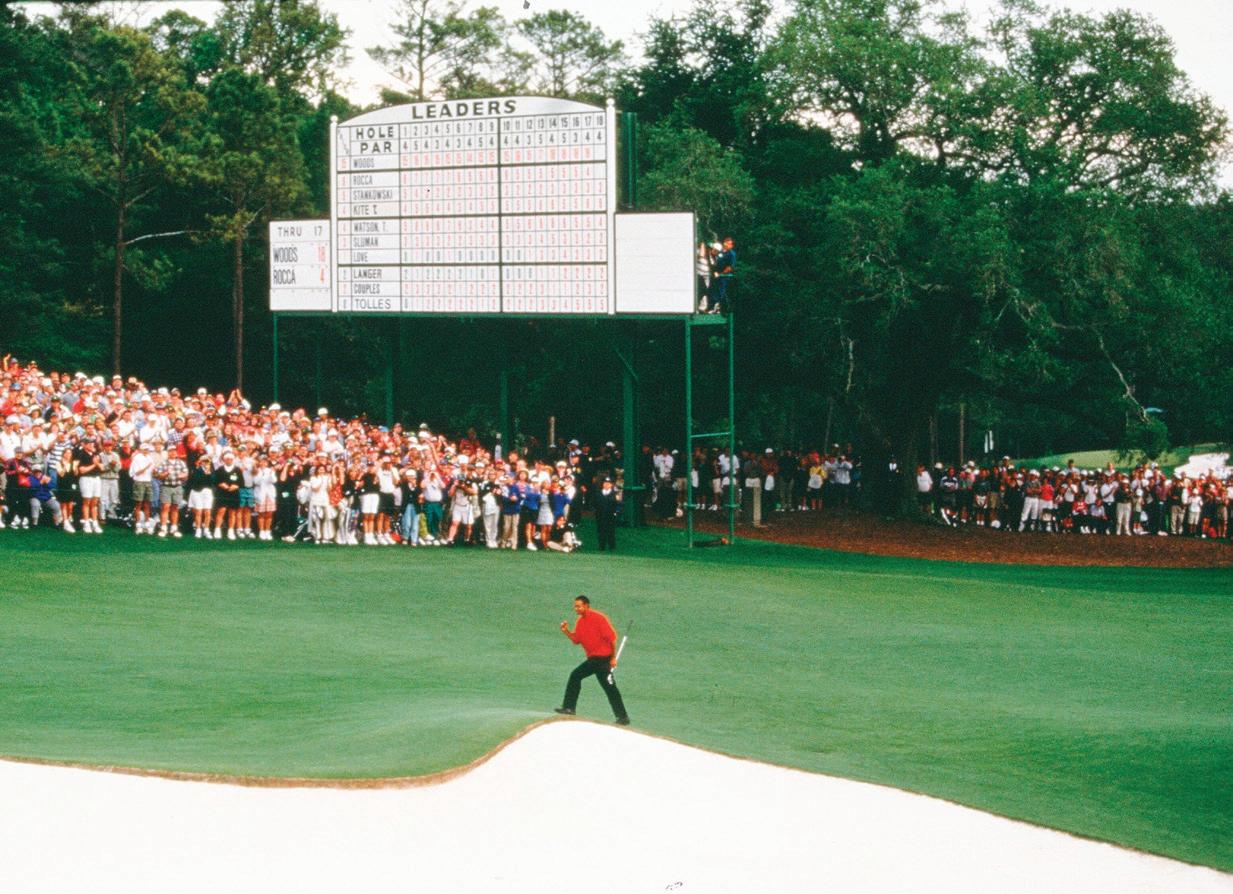
ust before Tiger went to the first tee on Sunday in his first major as a pro, I put my arm around him and said, “This is your day. Go out and enjoy it.” After 66-65 on Friday and Saturday, he had a nine-shot lead, but Tiger was never a bragger, never looked back, always what’s next. I remember his response, with a knowing smile: “I’ve got this, Butchie.”
Tiger was ready for this stage, and his game was perfect for Augusta National—his length off the tee, his high ball flight, pressure putting. He hit irons into most of the par 5s that week, even wedges into 15 a couple of times. As the vibe went from what could be to breaking records, he played even better.
On Saturday night, Tiger did what would become a ritual for him: He sat down with his yardage book in a room by
himself and played every hole in his head. Driver here, pick a club, aim there, knock it close, next hole. With all the variables in golf, Tiger was great at controlling what he could and being ready for the rest, even that week as a 21-year-old.
I told him on Sunday morning what Ben Hogan did when he was in contention: slow everything down. Walk slower, brush your teeth slower, drive to the course slower. Whether or not that landed with Tiger, he didn’t rush that morning. His putting, his warm-up were precise and calm, very routine.
We had talked about my dad, who won the Masters in 1948, saying the greatest feeling in the world is walking up the 72nd hole at Augusta with a five-shot lead, knowing you can’t lose. “Someday that’s going to be you,” I said. And there we were just a few days later, except Tiger’s lead was 12!
Tiger had arrived, ahead of schedule—to everyone but him.
hen José got to Augusta that year, it was already a major victory. Soon after he won the ’94 Masters, he developed foot pain that often left him unable to walk. He thought his career was over. Then, a back specialist found the source of the pain, and he finally got treatment that worked. As a result, his attitude coming in that week was, in a word, grateful.
Ollie and I had worked together for many years. His short game is one of the all-time best, and as a competitor, he’s as tough as they get. Plus, he absolutely loves Augusta.
It was a mixed bag for Ollie through the first three rounds: 70 on Thursday, a brilliant 66 on Friday, 73 on Saturday. Going into the final round, he was one shot ahead of Greg Norman, always a crowd favourite and now his pairing on Sunday.
The best story of that day happened on the par-5 13th. Still leading Greg by a shot, Ollie pushed his drive and laid up his second shot. Greg hit a big draw around the corner and a
perfect iron to about 25 feet. Then Ollie wedged on, maybe five feet inside of Greg’s ball. Here’s where it gets fun.
As Ollie tells it, he found himself taking in the scene as they stood on that green surrounded by all the beautiful azaleas in full bloom and rows and rows of patrons 10 deep. It was an odd time to be daydreaming, and then suddenly the crowd went crazy. Greg had made his eagle putt.
Now I’ve heard Ollie tell this story many times, and someone always asks, “What happened next?” Ollie will say his thoughts were, How great is this? I thought I might never walk again, and here I am on Sunday at the Masters playing with Greg Norman with a chance to win. Then, in his thick Spanish accent, he’ll add, “Oh, yes, then I make my putt for birdie.”
I tell my players this story all the time because it’s about appreciation. It’s natural to get caught up in the competition and miss the experience, the joy. Ollie went on to win by two, and I don’t think that ever would have happened without the gratitude he felt for just being there.

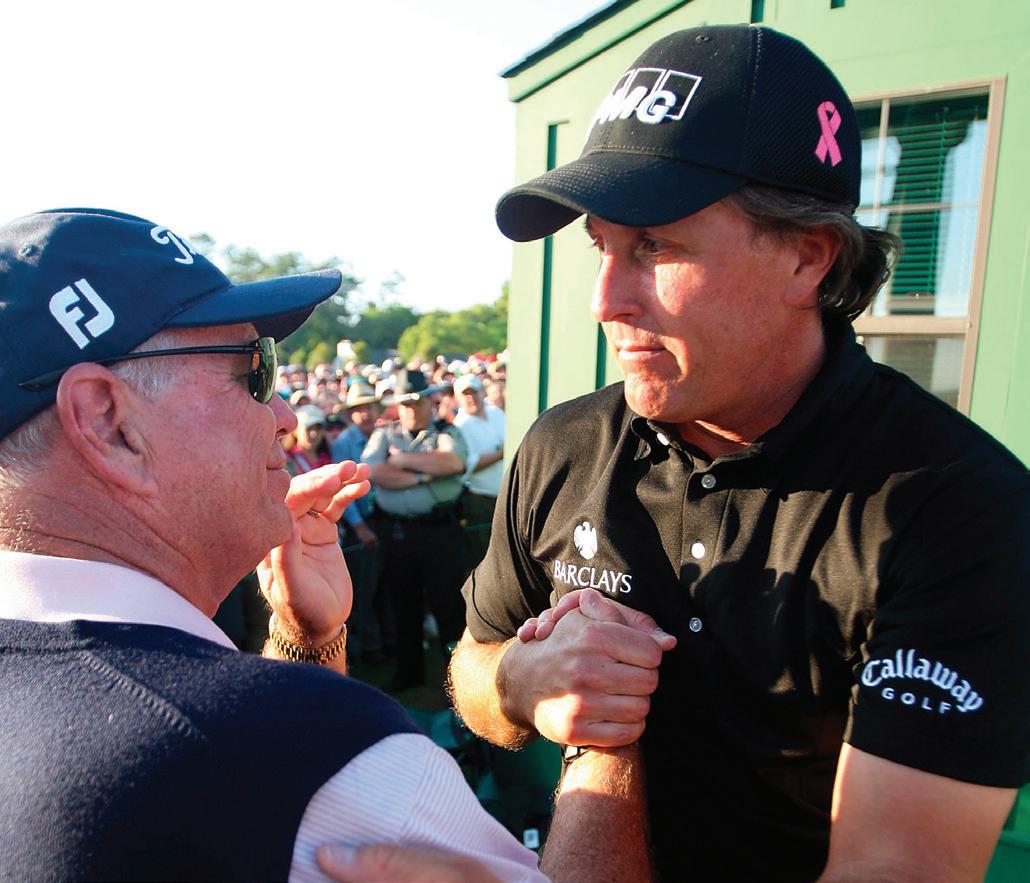
ometimes a major-championship victory can be traced to a single shot because it led to a birdie or eagle or gave the player a lift at a critical moment. In the case of Phil Mickelson’s clutch shot from the pine straw to the 13th green in 2010, it was both.
I’d been coaching Phil since early 2007, and that week he really had his driver clicking, which usually put him in contention. Playing with the lead on Sunday, he hit his tee shot on 13 through the dogleg and ended up behind a pine tree. His longtime caddie, Bones Mackay, was trying to convince him to play it safe and get in position for a wedge shot, but Phil was having none of that. With TV mics picking up their discussion, Phil leaned in and told Bones that sometimes you have to suck it up and hit the right shot at the right time. This was the right time, and he was hitting this shot.
The funny thing is, I had walked ahead to get into position to see the green and the next tee. By the time I heard the crowd explode and saw his ball stop four feet from the hole, I assumed he had pitched out and that was his third shot.
Nope. Phil had squeezed a 6-iron through the trees, carried it 200 yards over Rae’s Creek and dropped it next to the cup. It was a one-in-a-million shot.
He missed the eagle putt but made a longer one coming back for birdie to stay two ahead of Lee Westwood. The shot was critical to ensure a birdie, but the charge it gave Phil, a hugely emotional player, was what won him the tournament. Phil lives for pulling off the impossible. That boost helped him to make two more birdies coming in and win by three.
For me, the coolest part of that day happened after the round, when Phil was heading to Butler Cabin for the green jacket ceremony with Jim Nantz and then-Masters Chairman Billy Payne. I gave him a hug and said, “Go get another green jacket.” Phil said, “No way, you’re coming with me. This is you and me. We did this.”
No player had ever invited me to that ceremony. I was very proud of that gesture, still am, because it proved what our relationship meant to him. Phil was great about giving credit, whether it was to me or Bones or whomever. It was the second time that day Phil showed what he’s all about.
efore I get into what happened on Sunday in 2013, you have to understand how close I am to Adam Scott. To me and my wife, Christy, he’s like a member of the family. I met him when my friend Tom Crow, the founder of Cobra Golf, asked me to look after an Australian kid who was coming to play for UNLV, near where I teach outside Las Vegas.
When Adam came to see me for the first time in 1998, I was in the middle of my stretch with Tiger. I had Scottie hit some balls, and after a few swings I thought, I’ve seen this move before. I asked him if he’d tried to model his swing after anyone, and he said he and his dad loved Tiger’s swing and tried to emulate it. It was the closest I’d ever seen.
From that day on, Adam and I have been very close friends, sometimes working hard on his game, sometimes just keeping up on life. It was well known that an Australian had never won the Masters, with several near misses by Norman, and that fact was not lost on Adam, who is a proud Aussie.
In 2013, Scottie started the final round one shot off the lead,
and after the front nine, he trailed Angel Cabrera by three. But three birdies over the final six holes, including one at the last, put him in a sudden-death playoff with Cabrera.
They both parred the first playoff hole, then headed to No. 10. With rain coming down and the light fading, Scottie had a 15-footer for birdie to win. I was doing commentary for Sky Sports in the TV tower. I always try to stay neutral on telecasts and just say what I see, but this time it was hard. I also didn’t want to black-cat him by saying the wrong thing on television.
As he stood over that putt, I heard our producer in my ear: “Keep a camera on Butch. I want to see his reaction.” When the putt curled in, I went crazy, broke my cardinal rule. Then my on-air partner, Ewen Murray, turned to me and said, “Butch, what do you think?” I had tears streaming down my face. I couldn’t get the words out.
That’s as emotional as I’ve ever been watching one of my guys win. Scottie signed a Masters flag for me with the most beautiful message that starts, “Coach, mentor and great mate . . .” That flag hangs in the same hitting bay where I watched him hit those first balls 25 years ago.
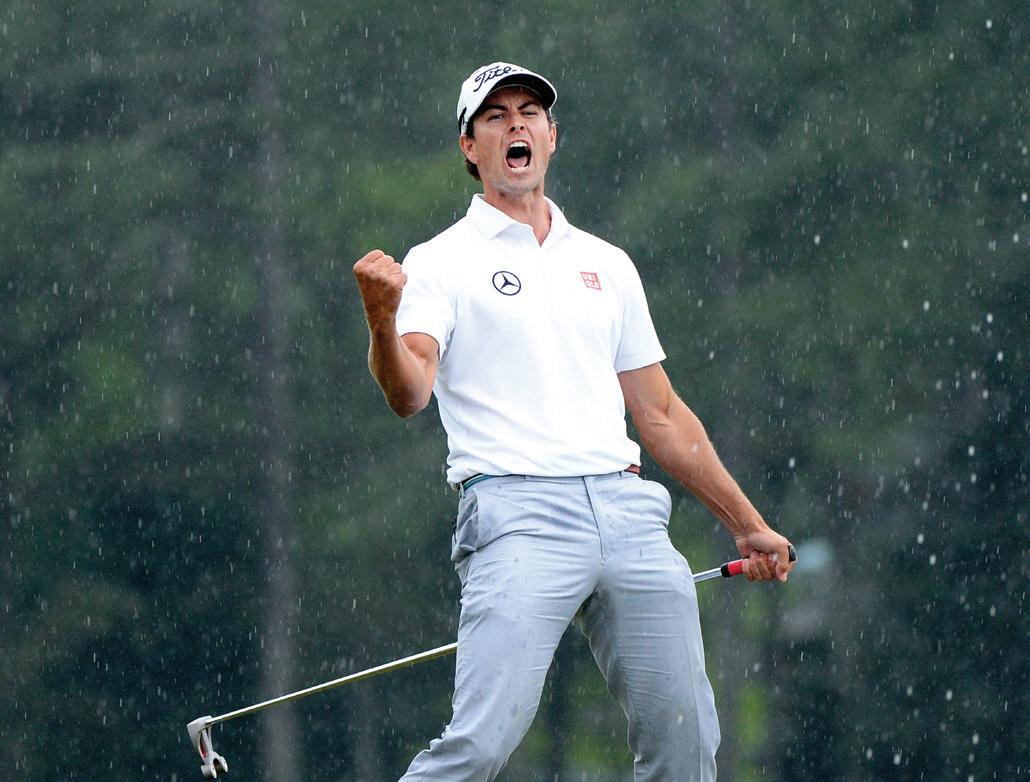
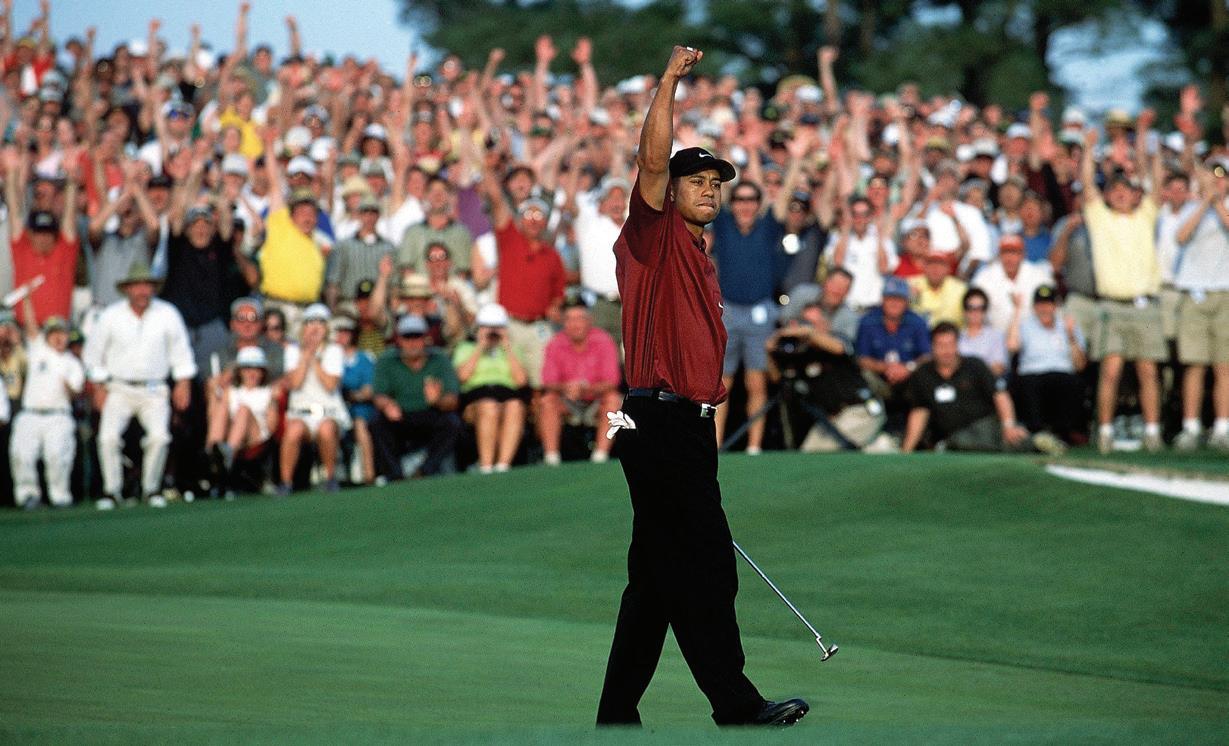
iger’s run in the majors during the summer of 2000 was the most dominant in history. He won the U.S. Open by a record 15 shots, the Open Championship by eight, then the PGA in a playoff. Winning the 2001 Masters would mean holding all four professional major titles at one time, which had never been done. Tiger was always comfortable with “never been done.”
Before we got to Augusta in 2001, he worked hard to keep up his form from the year before. His prep for majors was unlike any player’s I’ve ever seen. Not only would he practice shots in the weeks before a major that he knew he’d need, he would play them in tournaments leading up to it, even when the situation didn’t call for them.
That year, he won his last two events before the Masters— Bay Hill and the Players—and he was hitting his “Augusta shots,” like high draws with the driver and little spinny wedges, to win those tournaments. It was his secret prep that only we knew. By the time we got to Augusta, it was like he’d been competing there for weeks.
With the prospect of his winning four straight majors, it’s all anyone was talking about early that week. I knew the best thing I could do for him was not mention it. We kept our conversations light and his practice sessions crisp and routine. He did his workouts every morning, and when he got to the club, it was about warming up and focusing on how the
course was going to play that day—the wind, hole locations, shot shapes.
He did exactly what he had to for the first three rounds (70-66-68) to get himself in position to close out the so-called Tiger Slam and stood one shot ahead of Phil. Sunday’s preround preparations were impeccable. As usual, he spent time on the putting green first, finding the types of putts he anticipated having with Augusta’s Sunday pins, then went to the range to warm up.
As he headed to tee off, I took a quick moment with him, told him to go take care of business. He gave me a nod, didn’t even say anything, didn’t have to. We both knew the gravity of the day. I never really had a doubt that he would win, even before the week started. He was the best at his best.
Through nine holes, he was one shot clear of Phil and David Duval, and he kept his lead by a shot or two throughout the back nine. Standing on the 18th tee, he led David by a stroke and Phil by two. With history waiting, he hit his longest drive of the week up the last fairway, wedged it just right of the pin and then rolled in an 18-footer for birdie.
After the post-round hugs, I finally let myself think about what it all meant. It’s damn hard to win a major, but four in a row with the whole world reminding you of what’s at stake? I realised more than ever that those are the moments Tiger plays for. That’s his fuel. There’ll be other great feats in golf, but I don’t think anyone will touch the Tiger Slam.
include this as one of my unforgettable Sundays because if you were there, it left a mark on you. A six-stroke lead over Nick Faldo going into the final round dwindled to three at the turn, then it all went sideways. Greg shooting 78 after three under-par rounds, including a record 63 on Thursday, still seems crazy. But that’s why they play four rounds.
The simplest way I can put it is, when Greg showed up Sunday morning, he was not the same player who left Saturday night. He seemed uptight and agitated. We went to the range, and he said his swing didn’t feel right. I assured him there was nothing wrong with his mechanics; he was just quick from the top. We worked on getting him to finish his backswing, not rush the club down, but he just felt out of sorts.
Greg’s troubles really started in the middle of the round, when he hooked a 3-wood on No. 8 and was lucky to make par, followed by missing the green and not getting up and down
on 9 and 10. On 11, he hit two perfect shots to about 10 feet but lipped out the birdie and then missed the comebacker. The final blows were shots in the water on 12 and 16.
I was walking with Greg’s wife and daughter, and when things turned bad, it was hard to bear some of the comments in the crowd. When he pulled it badly into the water on 16, I suggested they walk in. There wasn’t anything more to see.
After the round, Greg’s caddie, Tony Navarro, and I waited for him in the locker room. I honestly didn’t know what to expect. Greg is very disciplined but also very intense. I’ll admit I was anticipating some things getting thrown around. But he walked in, looked at us and said, “I guess we just didn’t have it today, boys. We’ll get ’em next year.”
In hindsight, I shouldn’t have been surprised about how well he took it. Greg always had perspective. He kept his hand in various businesses, from equipment and apparel to things like wine, so it was never just the golf for him. He didn’t get it done that day, but you can’t break Greg Norman.
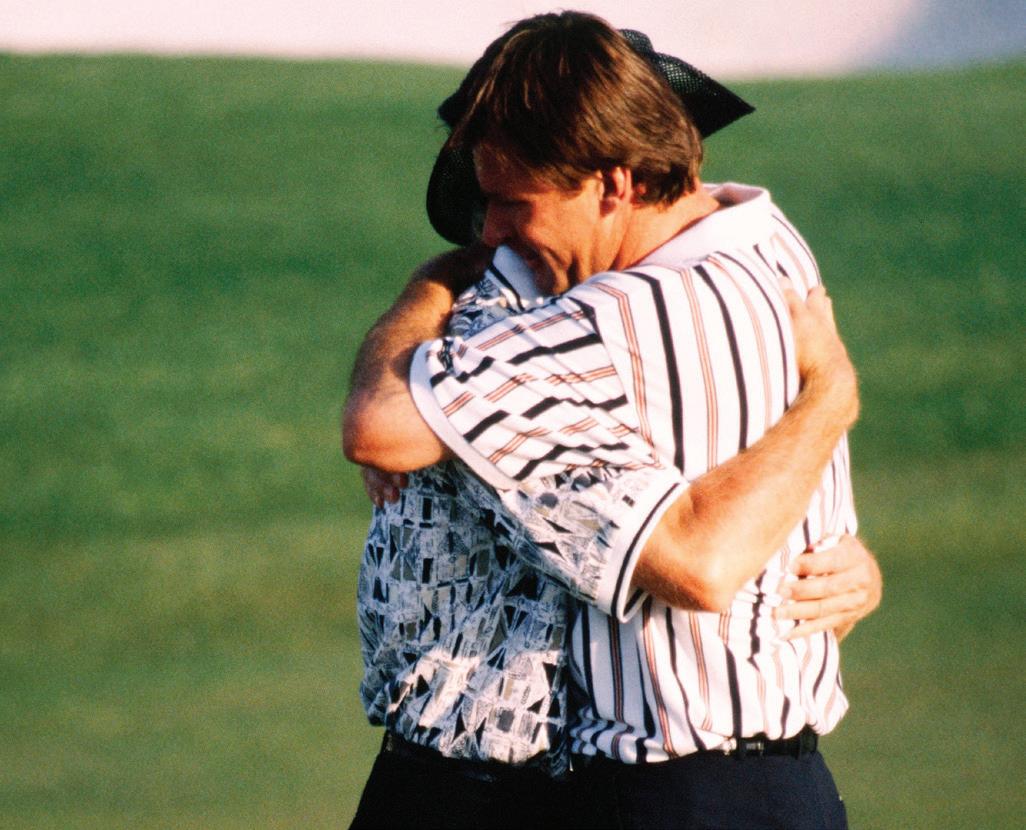
Oman is set to host the next edition of the Gulf Cooperation Council (GCC) Golf Championship, continuing the tournament’s legacy of promoting the sport across the region.
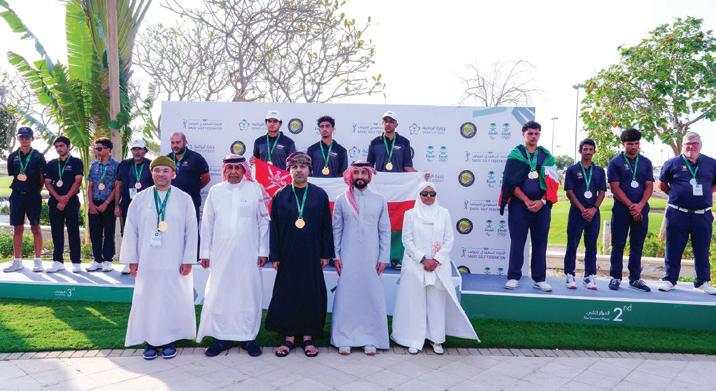
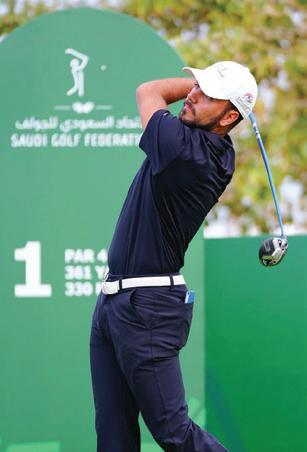
Ahmad Skaik creates history for UAE golf
Ahmad Skaik made history at the 2025 Men’s and Youth Cooperation Council (GCC) Golf Championship, held at Royal Greens Golf & Country Club in the Kingdom of Saudi Arabia, by delivering the lowest score ever recorded in the tournament. The UAE’s highest ranked amateur golfer dominated the field to secure the individual Gold Medal with a record-breaking final score of 18-under-par.
Ines Laklalech led the home contingent as one of five Moroccans in the field on LET in Rabat
In Morocco, at the opening event of the season on the Ladies European Tour, it was a moment to celebrate for the Arab contingent playing on home soil. With a field consisting of 34 nationalities worldwide, it included five Moroccans: Ines Laklalech, Maha Haddioui, Lina Belmati, Malak Bouraeda, and 15-yearold Sofia Cherif Essakali, who was the youngest player in the field. All five of the Moroccan players were in the top 50 of the leaderboard a er the first round in Morocco.
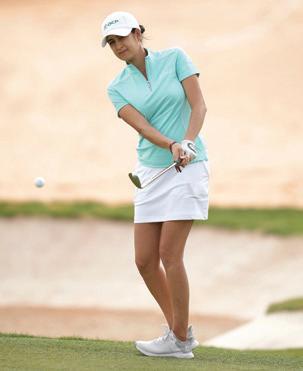
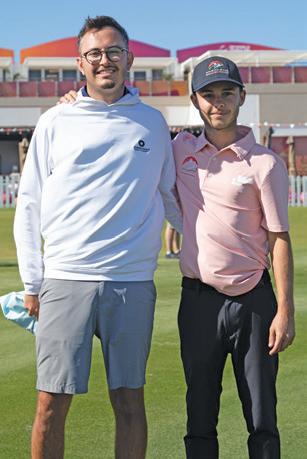
UAE’s Sam Mullane makes his mark on the
Sam Mullane made his mark on the DP World Tour at the 2025 Ras Al Khaimah Championship. It was a moment the UAE National player had been looking forward to at Al Hamra Golf Club. Prior to the tournament, Mullane got in a practice round with fellow UAE National pro-Adrian Otaegui and UAE National team member Ahmad Skaik. An opportunity for Mullane to pick the brains of five-time DP World Tour winner, Otaegui.
“It’s been a big week for me, for Morocco, and for Arab golf” Adam Bresnu reflects on Desert Classic

A five-over-par final round in the Hero Dubai Desert Classic is obviously not how I wanted to end the week. It was a tough day, to be honest. I made a stupid mistake on the seventh hole as I pushed it right. I was aiming le , and I just pushed it. It was a terrible shot. I bogeyed the eighth, and then on the ninth, my second shot went into the water, and I two-putted. I didn’t want to talk to anybody. I just wanted to be alone. But I’m human, I’m only 20 years old, and I’m learning.
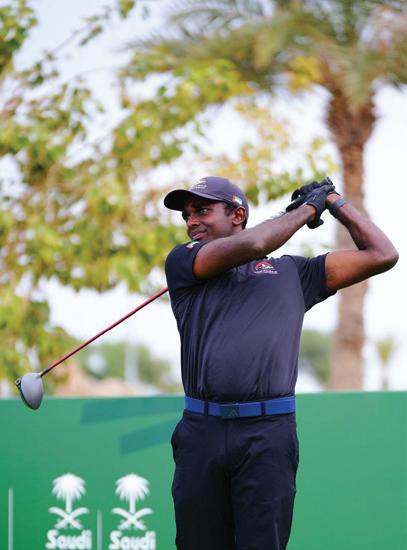
The UAE’s Jonathan Selvaraj fired a bogeyfree 66 in the final round of the Arab Professional Championship, capturing the second edition of the event by two strokes at Mazagan Beach & Golf Resort El Jadida in Morocco.
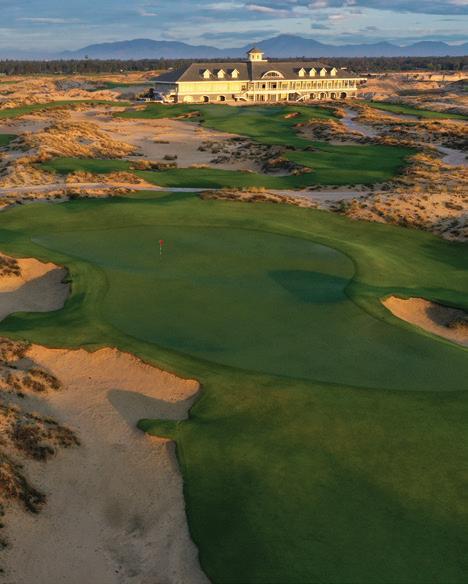
Comprising of 95 individuals, the 2025 Women’s AsiaPacific Amateur Championship field included seven players from the World Amateur Golf Ranking’s top-50 and 17 from the top-100. Iran’s Minoo Mousavi Nejad, Jordan’s Lilian Fuad and the UAE’s Hannah Cheryl Alan, Lara El Chaib and Intissar Rich proudly flew their country’s flags at Hoiana Shores Golf Club, Vietnam.
Karim Salam, President of the Lebanese Golf Federation, emphasised the tournament’s significance, stating: “We are proud to launch the Cedars Golf Championship as part of the Arab Golf Series, which aims to develop golf in the region and elevate Arab players’ standing on the international stage. This tournament will provide a valuable platform for amateur players to showcase their skills while fostering collaboration between Arab golf federations to deliver high-calibre tournaments. We extend our gratitude to the Emirates Golf Federation for hosting this round and look forward to strong competition among the participants.”


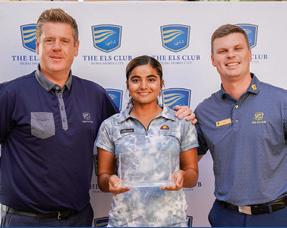
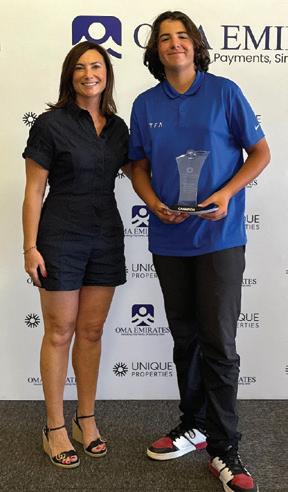
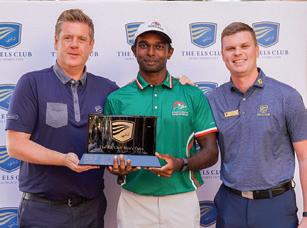

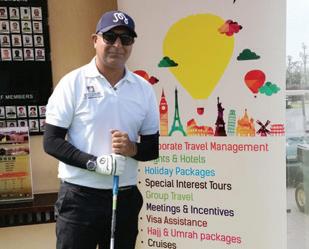

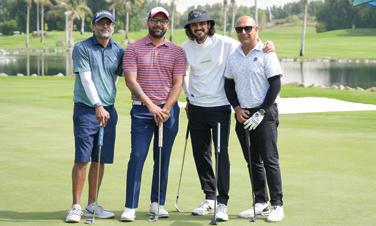
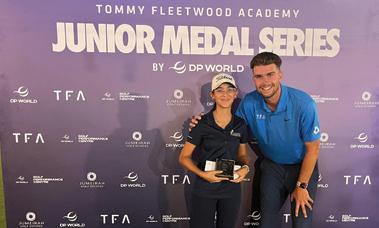

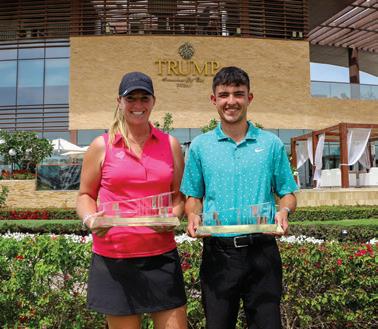



























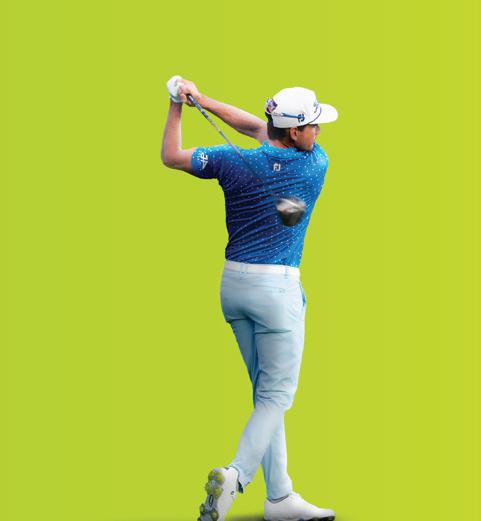







• Unlimited rounds on our 9 hole par 35 golf course.
• Pool and beach access for a family of four.
• Complimentary golf lesson and fitness assessment.
• Access to Gym
• Special savings on food and beverage outlets and spa.


Indulge in a season of unlimited golf this summer at JA Golf, located at Dubai's ultimate lifestyle resort. Elevate your game and enjoy unparalleled leisure with our Summer Swing package, where every swing brings a new discovery.
SCAN FOR MORE INFO Available from 1st June to 30th September 2025 AED 4,250 for Individual Package AED 7,500 for Couple Package
To book your Summer Swing package email golf.teetimes@jaresorts.com
